
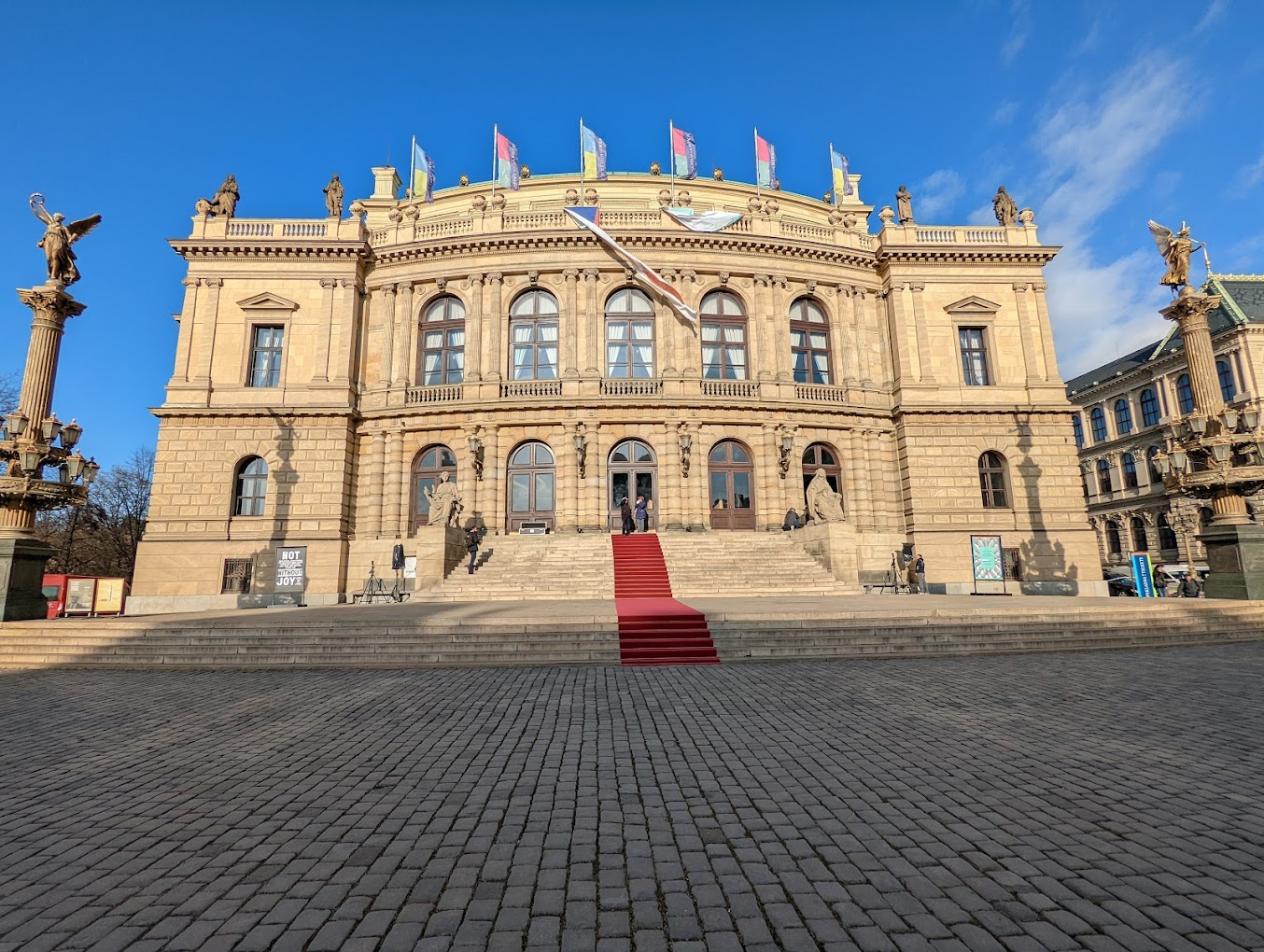


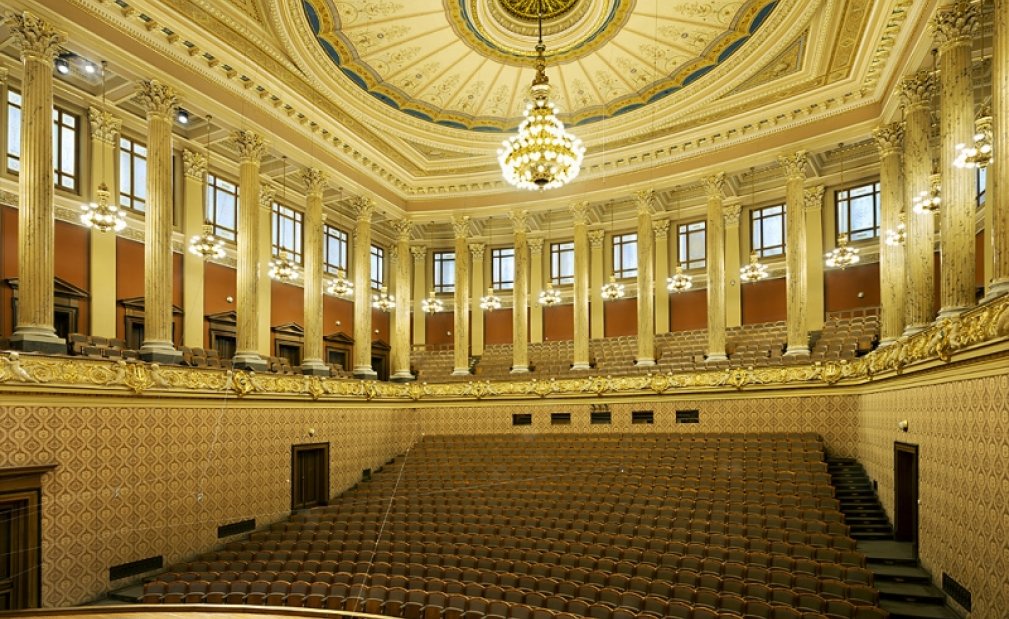

Das Rudolfinum (deutsch auch Rudolphinum) ist ein im Stil der Neorenaissance errichtetes Konzert- und Galeriegebäude am rechten Ufer der Moldau in der Prager Altstadt (Staré Město) in Prag. Das Gebäude gehört der Tschechischen Philharmonie, die hier ihren Sitz hat.
Geschichte
Das herausragende Gebäude aus hellem Sandstein wurde im Auftrag der böhmischen Sparkassen von den beiden Architekten Josef Zítek und Josef Schulz in den Jahren 1876–1884 errichtet. Die gerundete Fassadengestaltung lehnte sich an die der Dresdner Semperoper an. Schirmherr war Kronprinz Rudolf. Nach ihm und seinem kunstliebenden Vorfahren Kaiser Rudolf II. wurde das Gebäude benannt. Es war von Anfang an als ein Haus der Künstler (Dům umělců) konzipiert und sollte der Pflege der Musik und der Bildenden Künste dienen.
In der neu gegründeten Tschechoslowakei wurde das Haus im Jahr 1920 zum Abgeordnetenhaus umgestaltet. Unter der deutschen Besatzung durch die Nazis ab März 1939 wurde das Gebäude wieder zum Konzertsaal umfunktioniert. Anfänglich arbeiteten dabei nur tschechische Arbeiter, die, so erzählt man sich in Prag, bewusst statt der Statue von Felix Mendelssohn Bartholdy jene von Richard Wagner entfernten. Nachdem dieser „Irrtum“ aufflog, wurde der Rückbau durch deutsche Arbeiter fortgesetzt. Nach aktuellem Kenntnisstand ist diese Anekdote jedoch dem Roman Mendelssohn auf dem Dach von Jiří Weil entnommen und in der Realität so nie geschehen, da es zu keinem Zeitpunkt eine Statue von Wagner gab. Nach dem Zweiten Weltkrieg residierte in dem Haus nochmals kurz das tschechoslowakische Parlament. Seit 1946 dient das Gebäude aber wieder als Konzert- und Ausstellungsstätte. 1990 bis 1992 wurde das Gebäude restauriert.
Das Rudolfinum beherbergt drei Konzertsäle. In deren größtem, dem Dvořák-Saal, dirigierte Antonín Dvořák 1896 das erste Konzert der Tschechischen Philharmonie, des heute wichtigsten klassischen Prager Orchesters. Hier finden auch wichtige Konzerte des Musikfestivals Prager Frühling statt. Außerdem gibt es einen Suk-Saal und einen Kubelík-Saal.
Galerie Rudolfinum
Daneben befindet sich auch eine bedeutende staatliche Kunstgalerie, die Galerie Rudolfinum, in dem Gebäudekomplex. Deren Schwerpunkt liegt hauptsächlich auf Ausstellungen zeitgenössischer Bildender Kunst und zu einem geringeren Maße auch auf der sogenannten Klassischen Moderne. Wichtige Ausstellungen waren unter anderem: František Drtikol – Photographer, Painter, Mystic (1998), Cindy Sherman: Retrospective (1998), Jürgen Klauke: Side Effect (1998), Czech Photography 1840–1950 (2004), Annelies Štrba (2005), Neo Rauch: Neue Rollen (2007), Uncertain States of America (2007–2008), Gottfried Helnwein: Angels Sleeping (2008).
Weblinks
Commons: Rudolfinum – Album mit Bildern, Videos und Audiodateien
- Offizielle Website (tschechisch, englisch)
- Homepage der Tschechischen Philharmonie
- Homepage der Galerie Rudolfinum
Einzelnachweise
- ↑ History | Rudolfinum – englischsprachig. offizielle Website des Rudolfinum. Abgerufen am 8. November 2015.
- ↑ Das Prager Rudolfinum unter den Nationalsozialisten auf Radio Praha vom 13. Oktober 2009, abgerufen am 2. Mai 2011
https://de.wikipedia.org/wiki/Rudolfinum_(Prag)
Rudolfinum Combines Neo-Renaissance Beauty with Modern Technologies
The Rudolfinum breathtaking building is a gem of Prague Art Nouveau and masterfully enhances the concert and exhibition experience with its architecture. But few would expect a sophisticated system of state-of-the-art technology in a listed building. Yet it is the one that breathes, lights, heats, and cools the building and, unseen, unheard, day after day, takes care of the performers and visitors’ comfort, musical instruments, and exhibited works.
06.09.2022 | Author: Alice Horáková

Old buildings are beautiful, but nightmares from the energy point of view. At the same time, investments in energy-saving solutions are multi-million currency items. For this reason, the Czech Philharmonic decided to modernize its home headquarters in cooperation with CEZ Group in the form of energy performance contracting (EPC).
“Although Rudolfinum is a beautiful historical monument, it functions as a smart building by the most modern standards today. It adapts its heating and airflow to the number of spectators and uses the heat and cold from the nearby Vltava river. The savings are guaranteed directly in the contract and the contractor, which is us, guarantees them. Otherwise, we would have to pay the difference,” Kamil Čermák, CEO of CEZ ESCO, explains the mechanism of EPC projects.
Dry for paintings, wet for violins
CEZ Group’s experts have focused primarily on heat and cold production and air conditioning savings during the extensive modernization of energy management. “We had to cope with a number of conflicting requirements–the concert hall must be able to handle the heat radiated by 1,200 spectators, but the musicians cannot be cold on their fingers. The artworks on display tend to need drier air while the stringed instruments, on the other hand, require higher humidity to avoid destruction. It was a real challenge for our experts,” Čermák says.
Rudolfinum also not only functions as a concert and exhibition space, but also hosts educational programs for the general public, is rented out for social and business events, and houses a stylish café and a top-quality recording studio. By the way, the recording studio has one more peculiarity that the CEZ experts had to deal with: its extremely sensitive technology uses direct current, which is the reason why all the wiring in the Rudolfinum is controlled in this nowadays rarely used way.
Heat from Vltava
Rudolfinum does not have its own boiler room, but it uses the capacity of the one at the nearby Prague Conservatory. However, it now has a heat pump connected directly to the Vltava river. The water from the river helps with winter heating on one hand and summer cooling on the other hand. Even the actual placement of the heat pumps was not easy–the pavement had to be dismantled, the entrance to the shaft had to be broken through and this was then used to transport the pumps to the basement of the building.
The insulation also brought significant savings. The thermal audit showed that most of the heat escapes through the ceilings. The largest one above the Dvořák Hall could be insulated through the attic above it. However, the real problem was the second largest ceiling: the glazing above the Main Hall. Any intervention changing the aesthetics of the place would not be approved by the conservationists. But the experts eventually got to grips with that, too.
Quality Monitored by 5,000 Sensors
A more powerful, yet efficient ventilation system has been helping maintain a comfortable environment in the concert hall even during challenging summer months, when high humidity was a particular problem. At the same time, it allows to maintain the needed humidity level in the storage rooms for valuable musical instruments.
The fresh cool air flows evenly between the musicians through the stage floor during concerts, so it does not matter how far the musicians sit from the air conditioning: no one freezes nor overheats and everyone is comfortable. In turn, the air quality is monitored by sensors measuring CO2 concentration.
Controlling the efficiency of technology operation is generally very important as it allows one to look for additional savings and manage the whole complex as efficiently as possible. Experts receive data from a total of 5,000 monitoring points located in 134 rooms at Rudolfinum that are continuously evaluated.
The successful EPC project at Rudolfinum took place under the auspices of CEZ Group in 2015. The achieved savings (the Czech Philharmonic will pay up to 30% less for energy annually) will gradually amortize the initial investment of 20 million CZK, with an expected payback of nine years.
KV2 delivers tailor-made audio solution for Prague’s most prestigious concert hall
Conceived as a multi-purpose cultural centre combining exhibition rooms with concert halls, the Rudolfinum is one of the most architecturally remarkable buildings in Prague. It is also the home of the Czech Philharmonic Orchestra, which first performed in the Rudolfinum’s world-famous concert hall in 1896 under the baton of Antonín Dvořák. Today it is still the most prestigious concert hall in Prague and offers a dense and varied program of exceptional classical music concerts. The 1,100-capacity Dvořák Hall, named after the famous Czech composer, is renowned for its remarkable acoustics and is sought after for its unique atmosphere and for recording classical works.
Ahren Prohmann, world-renowned producer, music director, and winner of several Grammy Awards, remarked after making a complete recording of Dvořák’s symphonies in 2014 that none of the world’s famous old halls, such as the Musikverein in Vienna, the Concertgebouw in Amsterdam or the Symphony Hall in Boston, have such a highly recognizable sound as the Dvořák Hall. The acoustics are characterized by a very long reverberation, most notably in the mid frequencies and the distinctiveness of the sound in the Dvořák Hall is enhanced by other unique elements, such as the construction of the auditorium.
For many years, however, sound masters have struggled with the reproduction of amplified speech, especially with intelligibility and even coverage of the entire space. Efforts to resolve this have always run up against limitations in technology and the very strict requirements of the Rudolfinum’s listed building status, which do not allow technical installations that are not in keeping with the architectural aesthetics. “We have been struggling for a long time with insufficient intelligibility of the spoken word in the Dvořák Hall; it was never ideal due to the particular nature of the acoustics,” admits Radomír Stöhr, technical administrator of Rudolfinum.
George Krampera, the world-famous designer of sound systems and the founder of the Czech company KV2 Audio, undertook the task of resolving these issues with his team. His career spans over five decades in the development of professional audio technologies, many of which have become industry standards. His company’s philosophy is built on a unique technological approach, which is focused on achieving the highest possible dynamic range and the lowest possible losses caused by distortion and signal change when passing through individual parts of the sound chain. “Our technology respects many factors that are important for sound quality, whether we are talking about electronic integrity, sampling of digital systems, pulse response, dynamic range or acoustic design,” says Krampera.
David Mareček, CEO of the Czech Philharmonic, also welcomed the cooperation with KV2 Audio: “We have excellent experience with KV2 sound systems, in particular with the annual Open Air concert, which heralds the end of the Czech Philharmonic’s concert season in June. It is traditionally broadcast live on Czech Television.”
The physical constraints of the building meant that the spaces available for loudspeaker placement were not optimal for standard loudspeaker coverage patterns, so a bespoke solution had to be developed. The team, led by George Krampera, designed and built a fully customized system, not available in the KV2 catalogue, with custom horns designed to meet the unique dispersion requirements of the room. Equal emphasis was placed on both controlled dispersion and minimizing the effects of reverberation from above, by designing the system in such a way that it would not disperse towards the ceiling, but play directly towards the audience.
Utilising KV2’s SLA ethos they were able to solve many of the timing issues that would have been present if installing one of today’s third party DSP based solutions, solutions which are often extremely sensitive to feedback, and a problem that would have only been compounded by the extremely challenging acoustics of the room.
Technological advances through KV2’s Super Live Audio (SLA) research, such as a newly developed 5” low inductance midrange driver, meant the fastest and most accurate midrange was available as a critical part of the system design. This ensured clarity of vocal reproduction and extreme resolution, even in the most reverberant areas of the Hall. Should digital processing have been necessary, KV2’s industry leading DSD based 20MHz system was of course on hand, but on this occasion a pure analog signal path was the chosen solution.
Built into the fabric of the building where possible the stalls are covered by two three-way custom install passive column systems with very high resolution and controlled dispersion, equipped with six 10” speakers for low-mid frequencies, two 5” for midrange and one 1” speaker for highs. The balcony is served by a similarly designed three-way system with additional custom sidefills comprising four 6″ speakers for low-mids, one 5″ speaker for mid-high frequencies and one 1 “for highs.
Two ESP4000 amplifiers provide amplification for the passive full-range speakers in the Dvořák Hall, and two analog SAC2 analog controllers provide sound processing.
“At KV2, we try to minimize the distortion of the entire electroacoustic chain, which is why we have maintained the complete signal path in the highest possible, fully analog quality. We completely avoid any digital processing here, which really helps” emphasizes Krampera.
The sound booth for the Dvořák Hall is equipped with a pair of active EX6 speakers from the standard KV2 production portfolio and a Soundcraft analog mixing console, which has been specially modified in KV2’s labs for high-resolution sound. The choir benefit from a pair of passive ESD10 monitors, as well as a pair of ESD6s in the backstage area, all powered by ESP amplifiers.
The sound project also included the Suk Hall, which is historically the youngest hall in the Rudolfinum building. Completed in 1942 and decorated in a style inspired by the Rudolfinum’s original architects, the 190-capacity Suk Hall is ideal for chamber performances.
In 2015, the hall was completely refurbished with the aim of improving the acoustic properties. George Krampera’s team also equipped this space with a pair of specially designed three-way active speakers with very high resolution and controlled dispersion (4x 6” low-mids, 1x 6” mid, 1x 1.75” high). An important characteristic of this system is the full-range frequency response of the system coupled with its optimised coverage. Another interesting detail to aid aesthetics is the incorporation of the slim amplifier, with passive cooling, built into the wall of the hall itself.
“I am very proud of the work of my team who faced difficult conditions with this assignment, necessitating a majority of tailor-made, unique solutions. We were able to capitalize upon our many years of experience in building sound systems and fully respect the technological principles on which our company stands in order to deliver the audio experience they have been dreaming of for so long,” adds George Krampera.
In the vast majority of cases, the new sound system is used to reproduce the spoken word. Audiences and technicians alike are thrilled with the results, especially for televised broadcasts.
Related links:
Technical Summary of the KV2 Audio system
Dvořák Hall – stalls
Three-way custom installed passive speakers with very high resolution and controlled dispersion featuring a unique combination of 10”, 5” and 1” speakers.
Dvořák Hall – balcony
Three-way custom installed passive speakers with very high resolution, controlled dispersion and featuring a unique combination of 10”, 5” and a larger format VHD Technology 3” NVPD High frequency driver.
Sidefill – balcony
A smaller three-way passive speaker system featuring a combination of 6”, 5” and 1” components with very high resolution and controlled dispersion.
O:
- Monitor for choir: 2x ESD10
- Monitor – sound booth: 2x EX6
- Monitor – backstage: 2x ESD6
- Mix: Soundcraft Analog Mixer (modified by KV2)
Suk Hall
Three-way active speaker made up of multiple 6” speakers with a 1.75” compression driver featuring very high resolution and controlled dispersion.
https://www.kv2audio.com/news/kv2-delivers-tailor-made-audio-solution-for-pragues-most-prestigious-concert-hall.html
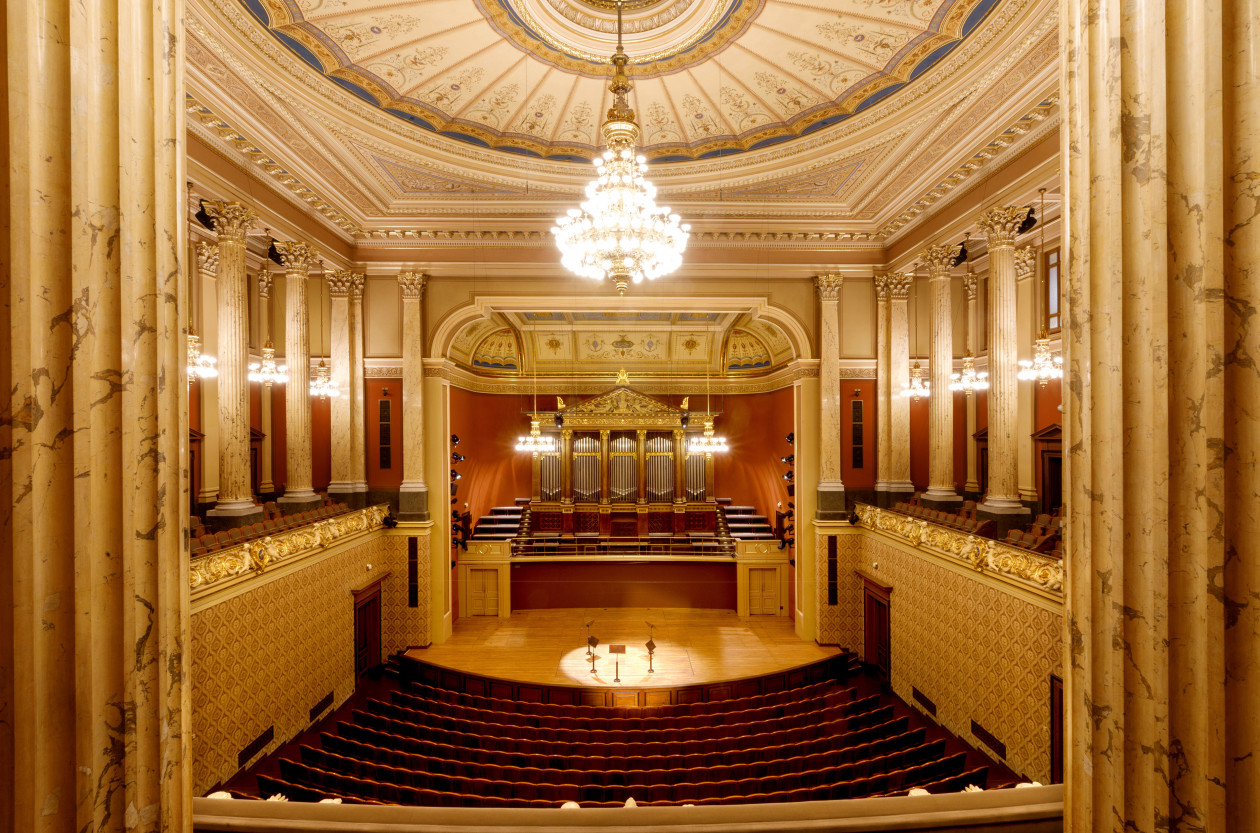
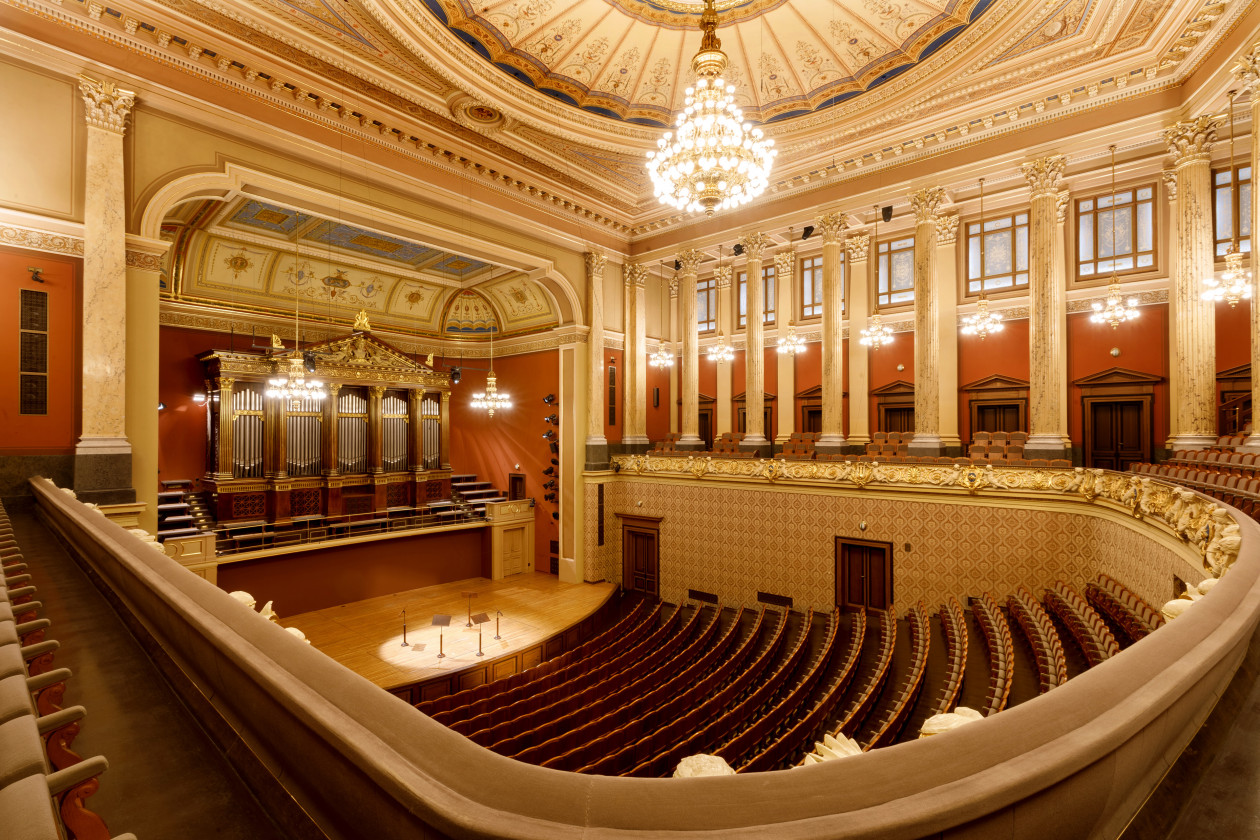

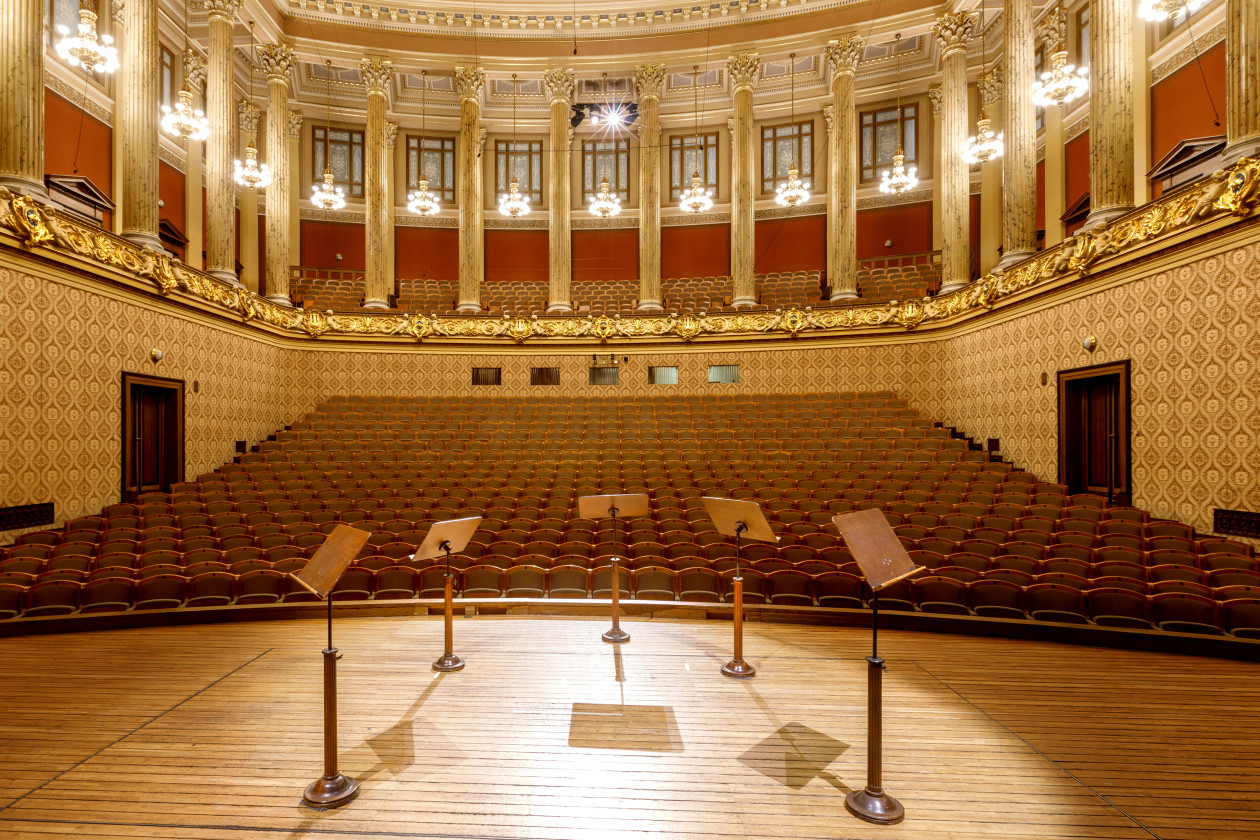

Dvorzak Hall

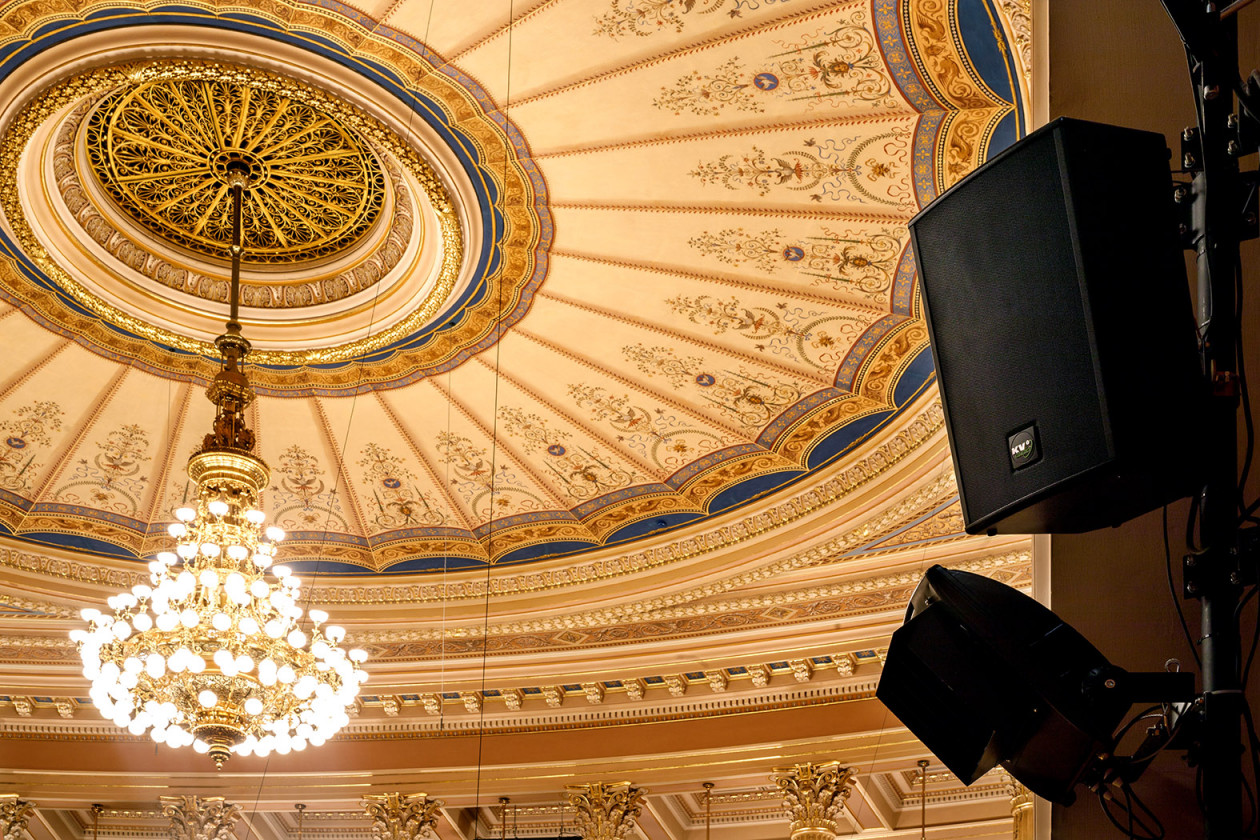

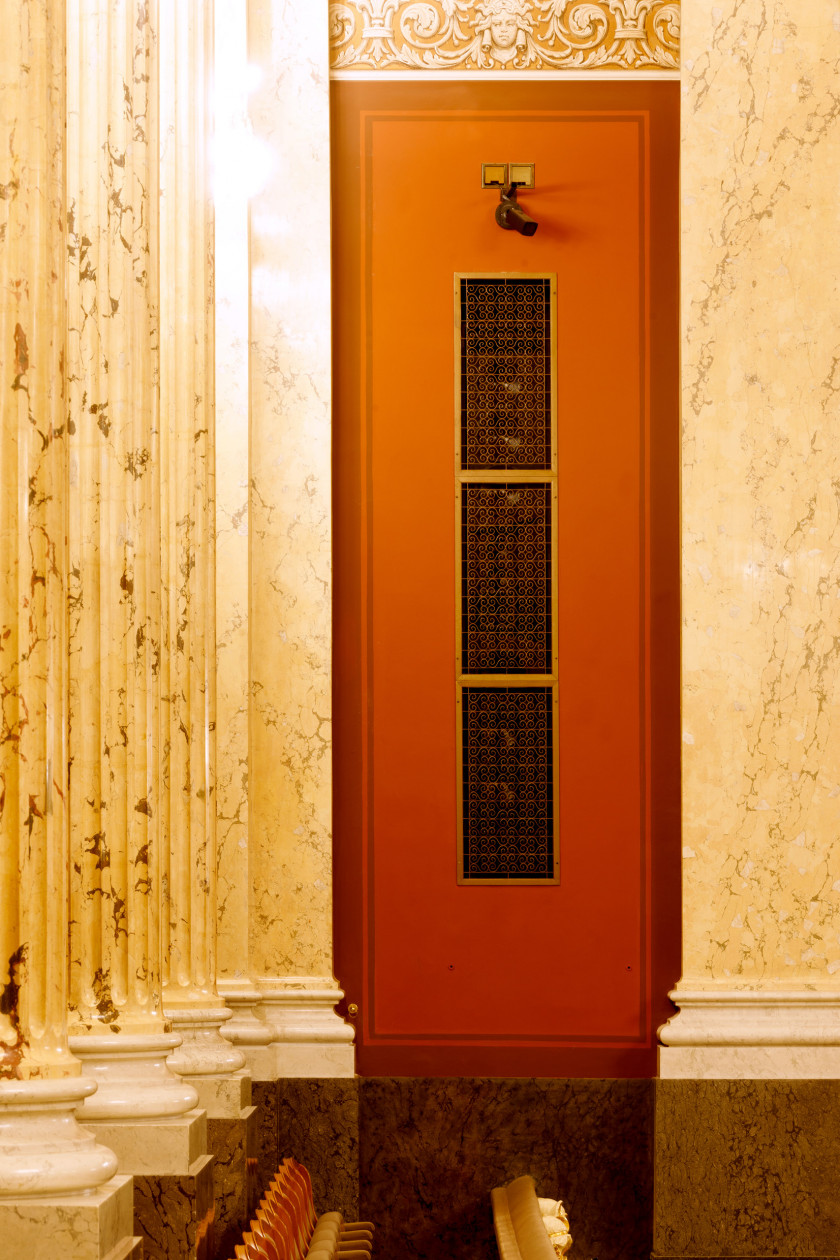
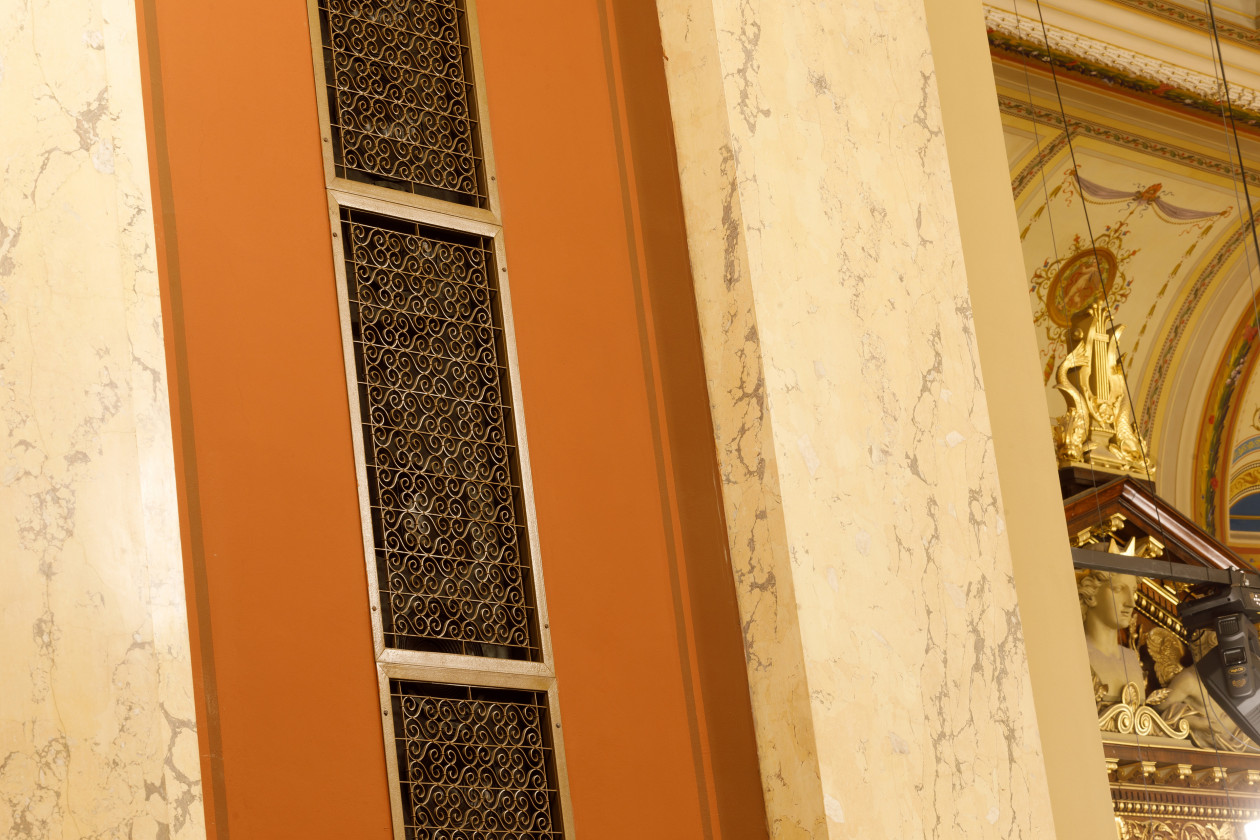

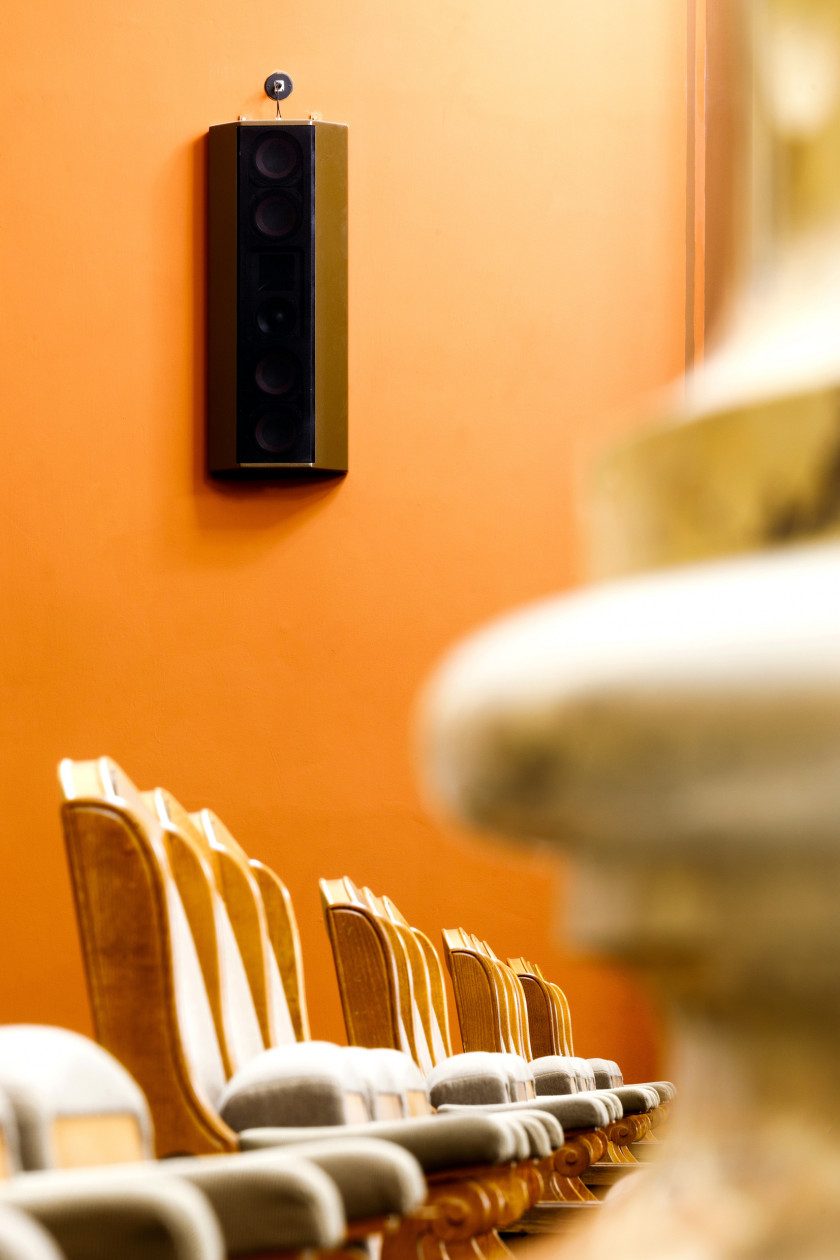

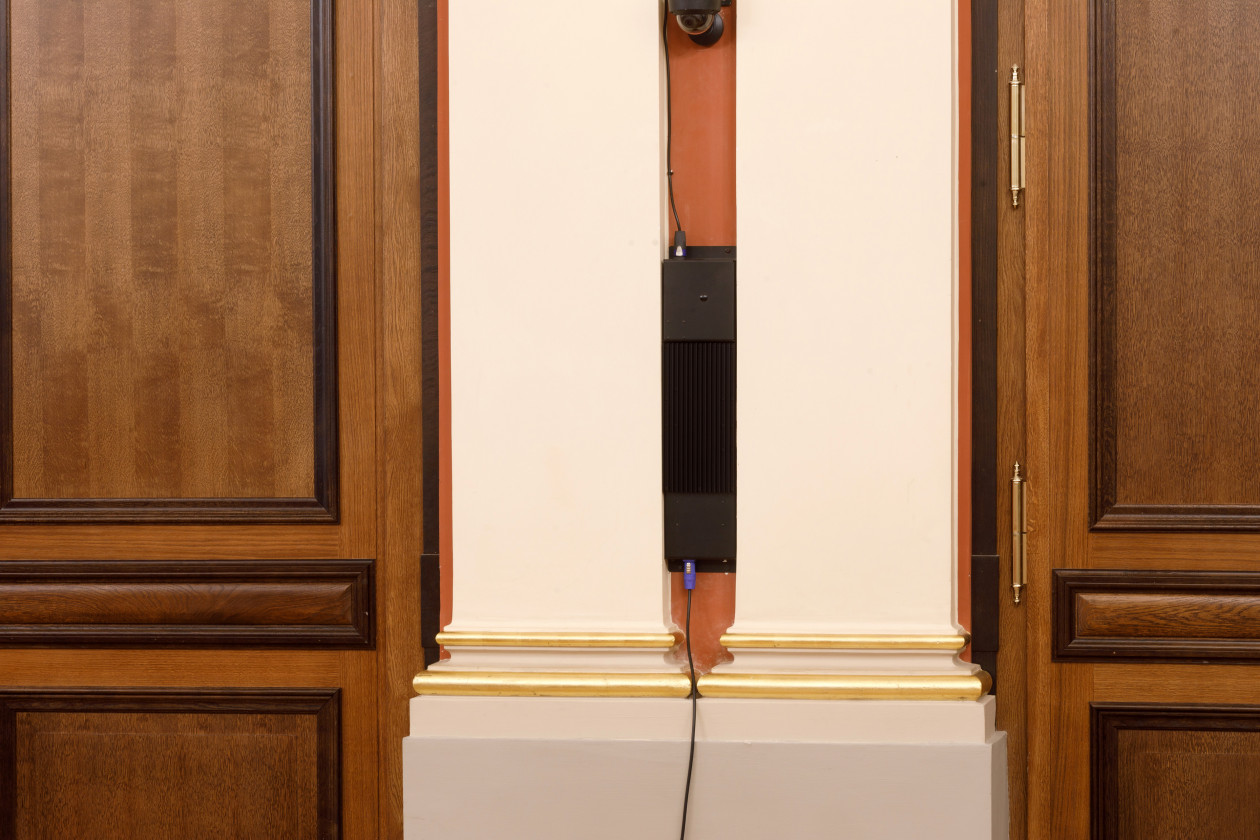
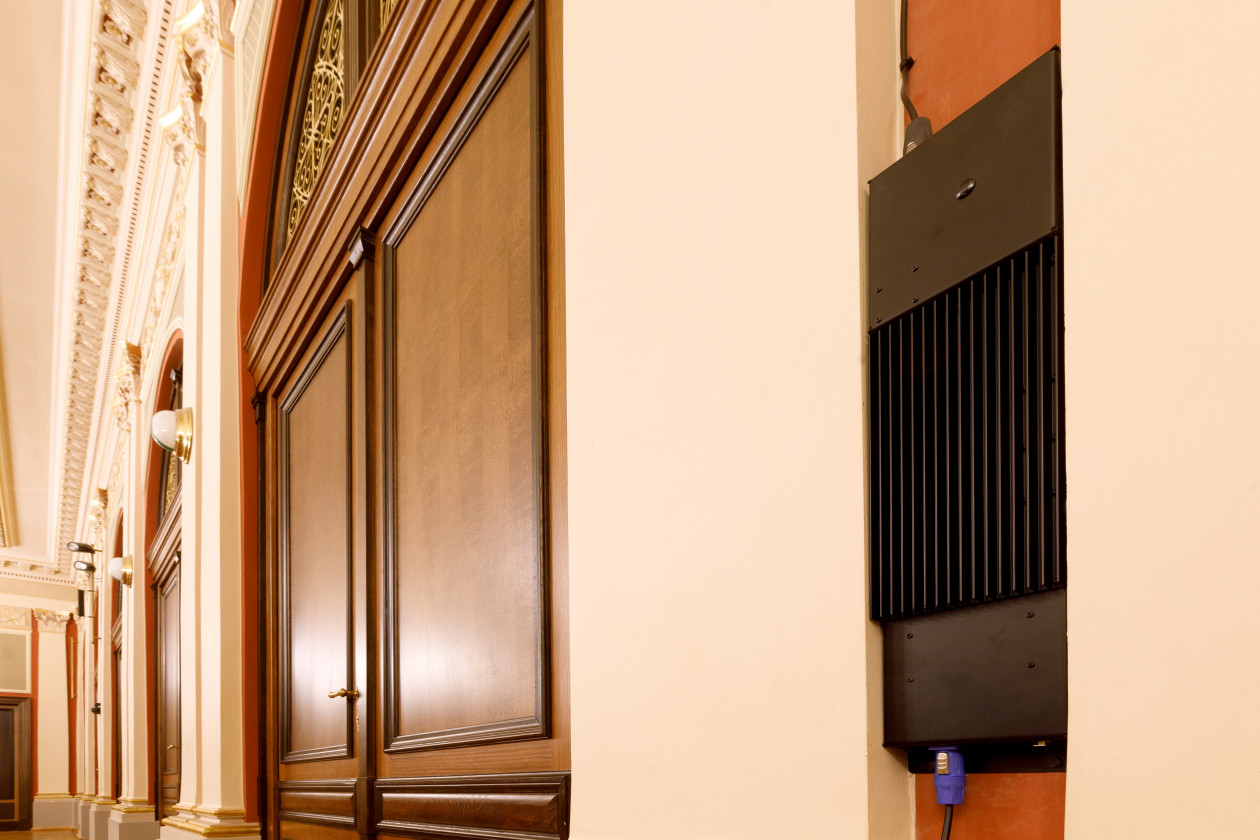
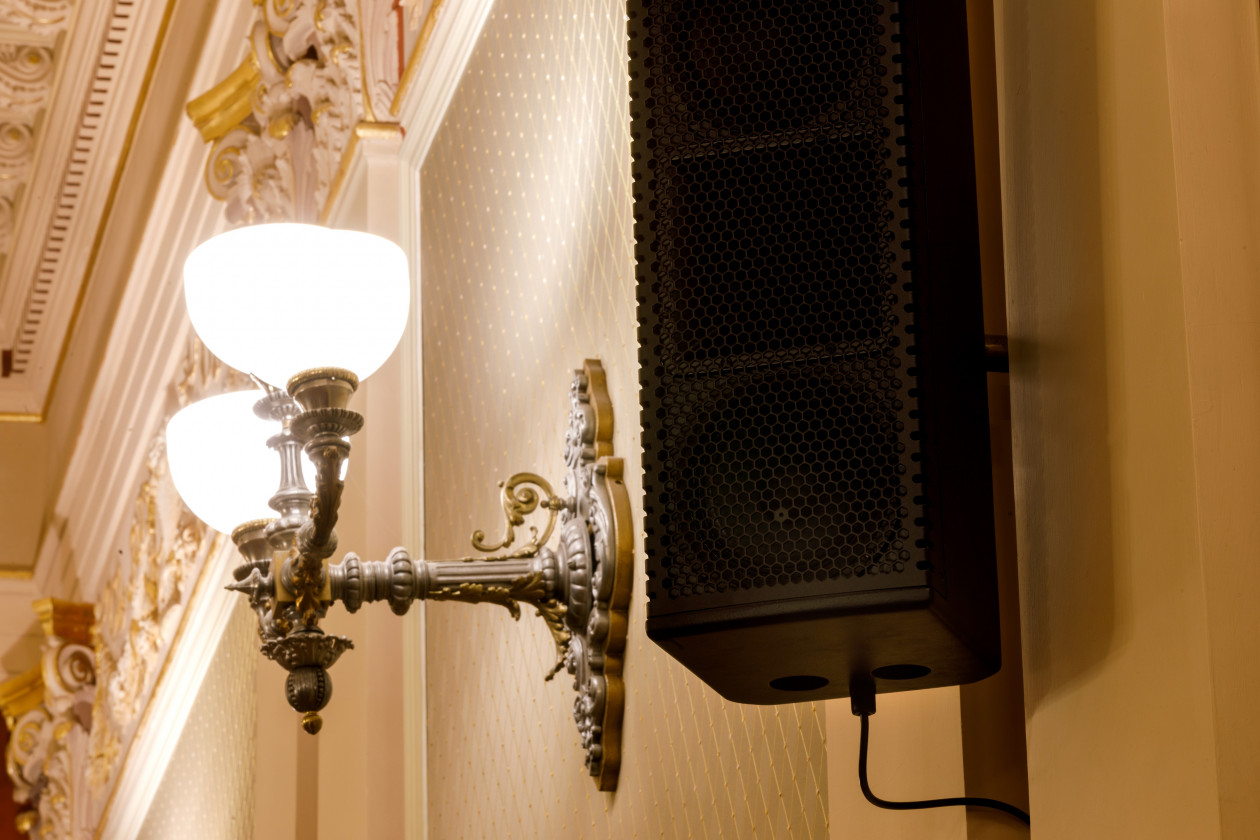


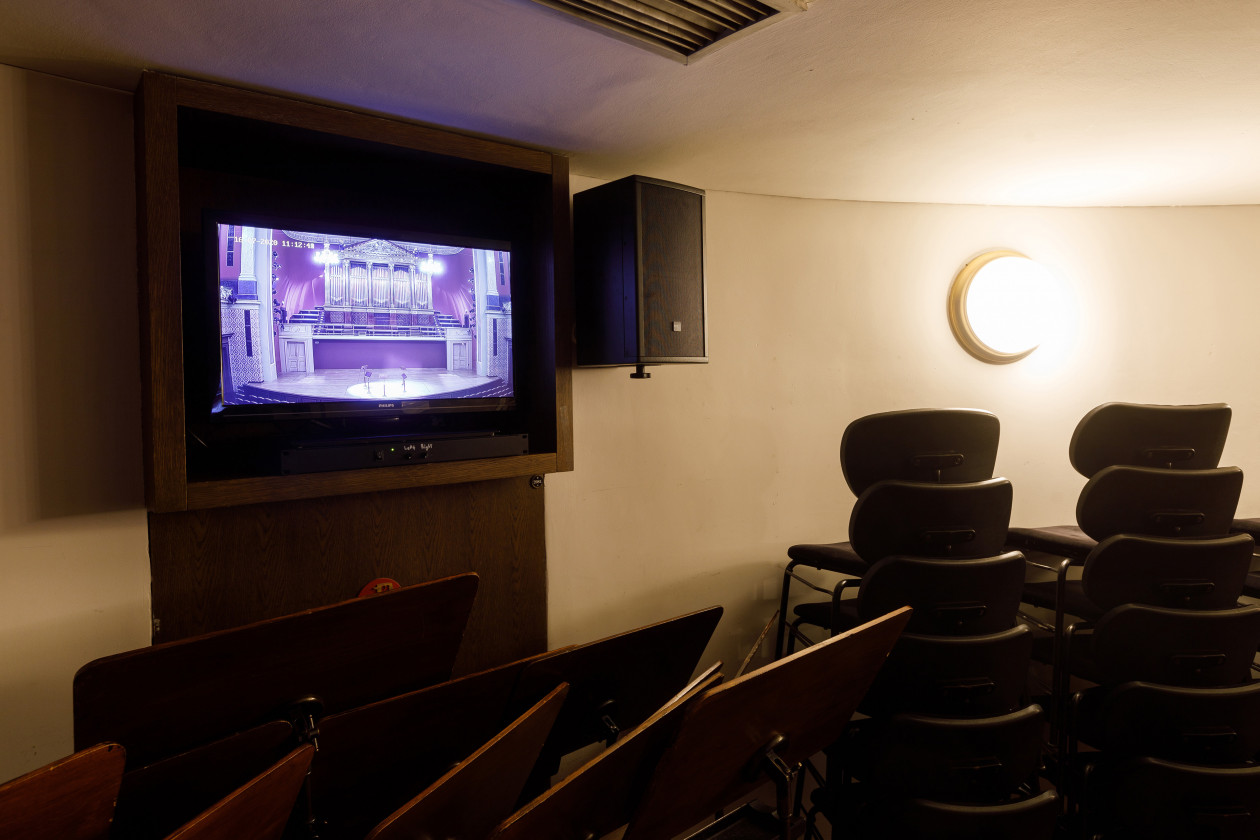
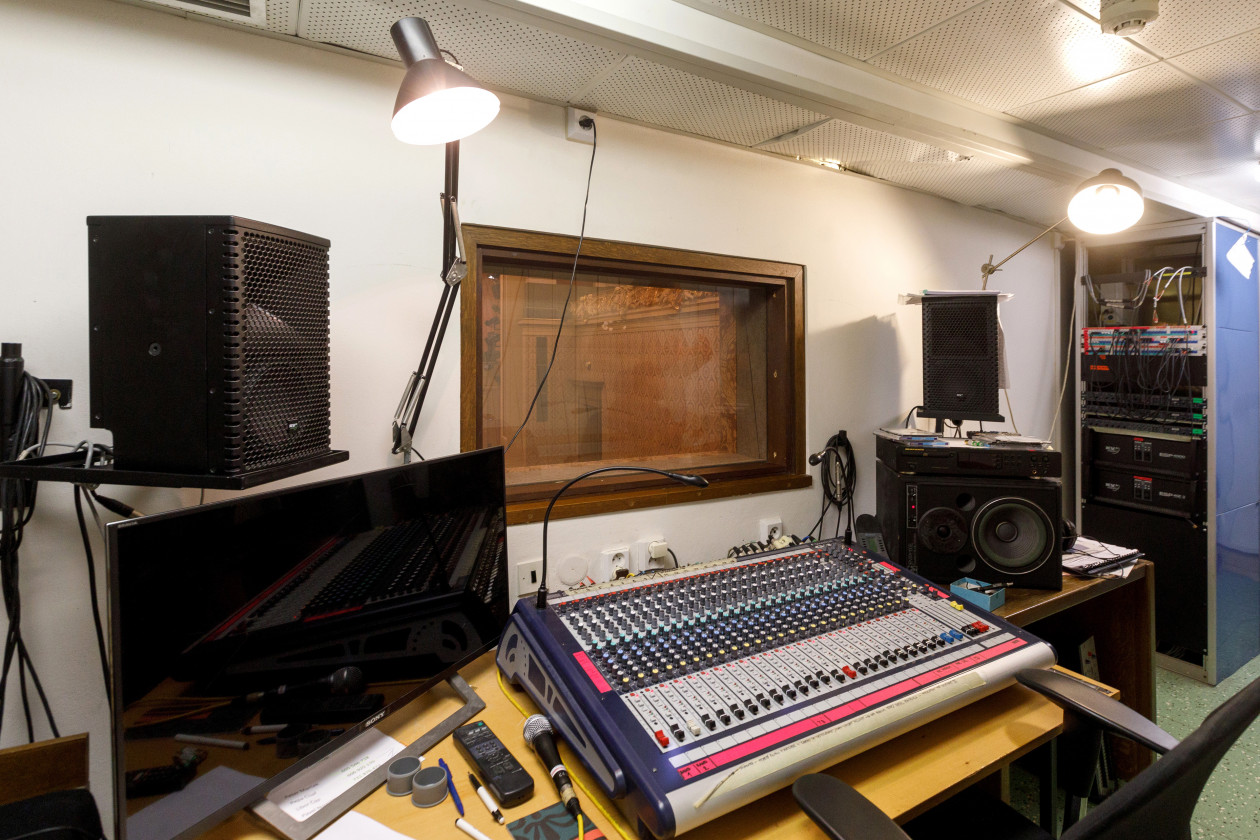
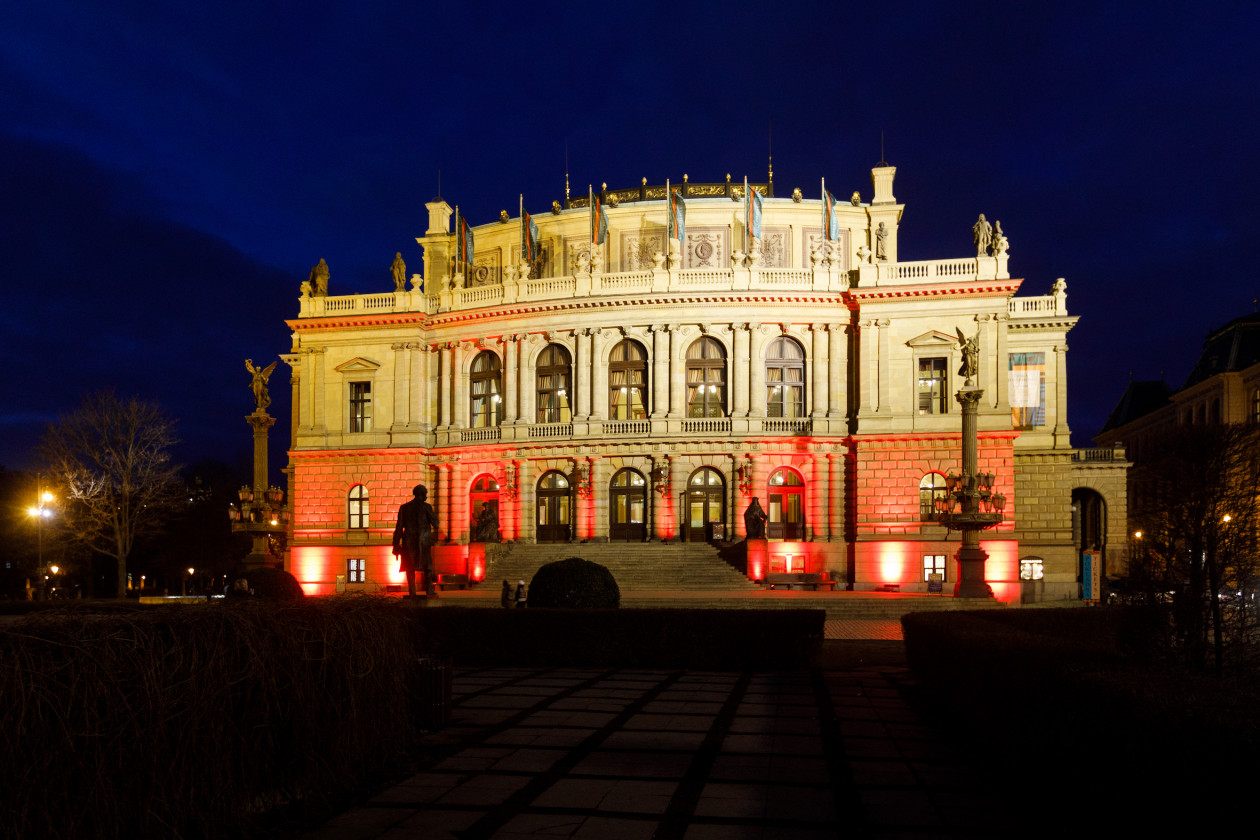
Rudolf von Österreich-Ungarn
Rudolf, Kronprinz von Österreich und Ungarn (vollständiger Vorname Rudolf Franz Karl Joseph; * 21. August 1858 im Neuen Schloss Laxenburg; † 30. Jänner 1889 auf Schloss Mayerling) war staatsrechtlich Kronprinz des kaiserlichen Österreich (Cisleithanien) und des königlichen Ungarn. Wie alle habsburgischen Prinzen trug er, den Hausgesetzen des Hauses Habsburg-Lothringen entsprechend, den Titel Erzherzog, im Ungarischen: főherceg, und war mit Kaiserliche und Königliche Hoheit anzusprechen.
Kindheit und Jugend
Er war der einzige Sohn von Kaiser Franz Joseph I. und Kaiserin Elisabeth. Der junge Kronprinz war sehr sensibel und sollte auf Wunsch des Vaters eine harte militärische Ausbildung erhalten. Der Sohn sollte ein guter Soldat, begeisterter Jäger und braver Katholik werden. Generalmajor Leopold Graf Gondrecourt wurde als Erzieher bestimmt. Er ließ das Kind stundenlang in Regen und Kälte exerzieren, weckte ihn auch gelegentlich mit Pistolenschüssen und ließ ihn in den Wäldern des Lainzer Tiergartens plötzlich alleine, das Kind in Panik versetzend.
Durch die harte Erziehung entwickelte der junge Rudolf deutliche Anzeichen von Hospitalismus, die sich in Angstzuständen, Unehrlichkeit und einer hartnäckigen Anhänglichkeit gegenüber seinen Bezugspersonen äußerte. Sein Leben lang begleiteten ihn ein hysterisches Schuldgefühl und krankhafte Selbstvorwürfe
Erst auf Druck seiner Mutter wurde diese Art der Ausbildung beendet und es wurden seine naturwissenschaftlichen Neigungen gefördert, da sie Joseph Graf Latour von Thurmburg zu seinem Erzieher bestimmte. So kam beispielsweise der deutsche Tierforscher Alfred Brehm an den Hof, um ihn zu unterrichten. Rudolf war ein wissbegieriges und lerneifriges Kind und von schneller Auffassungsgabe.
Unter dem Einfluss seines Lehrers Joseph von Zhishman kam Rudolf früh mit liberalem Gedankengut in Kontakt und begeisterte sich für das Idealbild des „Bürgerkönigs“ in Person von Louis-Philippe I. Auch in Kaiser Joseph II. sah Rudolf ein solches Vorbild.
Späteres Leben
Rudolf unternahm zahlreiche Reisen, zunächst in Europa, später auch auf anderen Kontinenten, über die er mehrfach Berichte – unter seinem Namen oder anonym – verfasste. Darüber hinaus regte er eine Enzyklopädie Österreich-Ungarns an, das so genannte Kronprinzenwerk, und schrieb darin selbst mit. Außerdem war Kronprinz Rudolf ein angesehener Ornithologe.
Rudolf äußerte sich schon in Jugendjahren häufig antiklerikal, was ihm die Kritik seines Vaters und seines erzkonservativen Großonkels Albrecht einbrachte. Trotz seines Antiklerikalismus war Rudolf jedoch keineswegs antichristlich, sondern lobte ausdrücklich die Gesinnung des Urchristentums. Er zeigte ein ausgeprägtes Interesse an der „sozialen Frage“, wobei es dem Kronprinzen vor allem um praktische Hilfestellung für die von Armut Betroffenen ging.
Politisch stand Rudolf der liberalen Verfassungspartei nahe. Dementsprechend bevorzugte er einen starken Zentralstaat gegenüber einer Föderalisierung des Habsburgerreiches und eine Stärkung des „multinationalen Bewusstseins“ gegenüber nationalen Sonderrechten.
Militärdienstzeit und Liebesaffäre in Prag
Nach dem Ende seines Studiums übersiedelte Rudolf 1878 nach Prag, wo er im Infanterieregiment Nummer 36 seinen Militärdienst leistete (1878 Oberst, 1880 Generalmajor, 1882 Feldmarschallleutnant, 1888 Gen. Inf. Insp.).
Laut Berta Zuckerkandl, Tochter des Zeitungsverlegers und langjährigen Rudolf-Freunds Moriz Szeps, hatte Rudolf in Prag eine Liebesaffäre mit einer jungen Frau jüdischen Glaubens – seiner Enkelin Stephanie Windisch-Graetz (1909–2005) zufolge seiner großen und einzigen Liebe. Nach Spitzelberichten im Akt des Wiener Polizeipräsidenten Franz von Krauß begleitete diese Geliebte ihn sogar zur Brautschau an den Brüsseler Hof. Sie starb, nachdem sie aus ihrem Exil ausgebrochen war, in das man sie verbannt hatte.
Heirat mit Stephanie von Belgien
Auf Druck des Kaisers musste Rudolf 1881 Prinzessin Stephanie heiraten, Tochter des belgischen Königs Leopold II. Sie war die Cousine zweiten Grades von Rudolfs Vater Franz Joseph, da ihre Mutter Marie Henriette eine Enkelin von Kaiser Leopold II. war. Die Hochzeit fand in Wien statt.
Das Paar lebte einige Zeit in Prag, wo es wiederholt zu Auseinandersetzungen kam. Nach der Geburt ihrer Tochter, Erzherzogin Elisabeth Marie, 1883 in Laxenburg kehrten sie nach Wien zurück.
Tod in Mayerling
Rudolf litt unter starken Stimmungsschwankungen. Vermutlich nahm er sich in der Nacht vom 29. auf den 30. Jänner 1889 in Schloss Mayerling durch einen Schuss in den Kopf das Leben. Die 17-jährige Baroness Mary Vetsera starb ebenfalls dort. Dem Bericht des Arztes zufolge war sie von Kronprinz Rudolf erschossen worden. Dass die Baroness tatsächlich durch einen Kopfschuss starb, ist inzwischen überprüft. Die Wiener Hofärzte obduzierten den Leichnam des Kronprinzen und attestierten aufgrund pathologischer Befunde des Gehirns, die Tat sei in einem „Zustande von Geistesverwirrung geschehen“, wodurch der Kronprinz mit allen kirchlichen Zeremonien beigesetzt werden konnte. Baroness Mary wurde in das Stift Heiligenkreuz gebracht und auf dem Friedhof der Zisterzienserabtei beerdigt.
Bereits Anfang Februar 1889 erschienen in der deutschen Presse verschiedene Berichte über Kronprinz Rudolf und die Baroness, deren Verbreitung in Österreich-Ungarn jedoch am 15. Februar aufgrund einer Entscheidung des k. k. Landesgerichts in Troppau verboten wurde.
Der Verlauf der schicksalhaften Nacht ist bis heute ungeklärt, nachdem die Zeugen (darunter Rudolfs Kammerdiener Johann Loschek) ihr Leben lang schwiegen oder widersprüchliche Aussagen machten. Viele Dokumente wurden vernichtet. Die angebliche Tatwaffe gelangte später in den Besitz Ottos von Habsburg (1912–2011), der sie zeitlebens nicht herausgab. Der Suizid des Kronprinzen erschütterte das Vertrauen in die habsburgische Monarchie.
Zita, Ottos Mutter und Ehefrau des letzten Kaisers Karl, beharrte in ihren letzten Lebensjahren Historikern gegenüber darauf, dass Rudolf und Mary Vetsera in Mayerling nicht vom Kronprinzen selbst getötet wurden, sondern „politischen Meuchelmördern zum Opfer gefallen“ seien, wie das deutsche Nachrichtenmagazin Der Spiegel in seinem Kurznachruf zu Zitas Tod 1989 berichtete. Nach Meinung Zitas sei Rudolf „Opfer eines politisch motivierten Mordanschlags“ einer ausländischen Verschwörung gewesen, weil er sich nicht an einer Verschwörung zum Sturz Kaiser Franz Josephs beteiligen, sondern diese aufdecken wollte. Auftraggeber sei nach Zita der französische Staatsmann Clemenceau gewesen. Brigitte Hamann, selbst Autorin einer Rudolf-Biografie, bezeichnete diese Aussagen in einem Interview mit der österreichischen Wochenzeitschrift profil im Jahr 2005 als „gezielte Vernebelungstaktik.“
Rudolf setzte in seinem Testament vom 2. März 1887 seinen Vater Kaiser Franz Joseph als Testamentsvollstrecker ein. Darüber hinaus bat er ihn, für seine Tochter Elisabeth Marie (1883–1963), die er gleichzeitig zu seiner Universalerbin machte, die Vormundschaft zu übernehmen.
Nach Rudolfs Tod wurde nach den habsburgischen Hausgesetzen sein Onkel Karl Ludwig österreichisch-ungarischer Thronfolger.
Sonstiges
Bei seiner Taufe wurde sein Name Rudolph geschrieben, ebenso bei seiner Heirat 1881, in einem Nachruf 1889 Rudolf. Die nach ihm benannte Kronprinz-Rudolf-Bahn führte schon bei ihrer Gründung nur den Namen mit f. 1903 kam es im ganzen deutschsprachigen Raum zu einer Rechtschreibreform, bei der ph-Schreibungen auf f geändert wurden.
Rudolf war Förderer des k.u.k. Heeresmuseums (heute Heeresgeschichtliches Museum) in Wien. Ab 1885 war er Vorsitzender des Komitees, dem die Bildung und Ausgestaltung des Heeresmuseums oblag
Mizzi Kaspar (1864–1907) war Rudolfs langjährige Geliebte. Rudolf wollte sich zusammen mit ihr umbringen, doch sie wollte nicht mit ihm sterben. Sie informierte die Polizei über Rudolfs Suizidpläne, was aber nicht weiter verfolgt wurde. Rudolf verbrachte seine letzte Nacht in Wien, vom 27. auf den 28. Jänner 1889, bei ihr; am Morgen brach er nach Mayerling auf. Rudolf vermachte Kaspar (zu dieser Zeit 24 Jahre alt) in seinem Testament 30.000 Gulden.
Kaiserin Elisabeth ließ vom Schweizer Steinmetzen Antonio Chiattone im Park ihres griechischen Schlosses Achilleion (Korfu) ein Denkmal für den verstorbenen Sohn Rudolf errichten. Das Monument zeigte Rudolf in einem Medaillon, über dem ein Genius schwebte, der sich an einen abgebrochenen Säulenstumpf lehnte. Die Inschrift in lateinischer Sprache war Rudolf gewidmet. Das Denkmal wurde am 22. April 1894 im Beisein der tief ergriffenen Kaiserin enthüllt, jedoch bereits nach kaum drei Jahren wieder entfernt und in Mayerling aufgestellt. 1935 kam es in den Garten der Rudolfstiftung, wurde aber von den Bombardierungen im Zweiten Weltkrieg schwer beschädigt.
Ehrungen
Statue Rudolfs von Miklós Ligeti in Budapest
Mehrere Objekte waren bzw. sind nach Rudolf von Österreich-Ungarn benannt:
- Wien
- Rudolfsbrücke über den Wienfluss (nicht mehr existent) – zwischen dem 1. Bezirk Innere Stadt und dem 3. Bezirk Landstraße
- Kronprinz-Rudolf-Brücke über die Donau – zwischen dem 2. Bezirk Leopoldstadt und dem 22. Bezirk Donaustadt; umbenannt 1919 in Reichsbrücke
- Rudolfskaserne (heute: Rossauer Kaserne) – im 1. Bezirk Innere Stadt
- Rudolfsplatz – im 1. Bezirk Innere Stadt; benannt im Jahr 1862
- Rudolfstiftung – städtisches Krankenhaus in der Juchgasse 25 im 3. Bezirk Landstraße
- Rudolf-Hof – in der Hörlgasse 15 im 9. Bezirk Alsergrund
- Rudolfsheim – heute Bezirksteil des 15. Bezirks Rudolfsheim-Fünfhaus
- Rudolfinerhaus – Spital in der Billrothstraße 78 im 19. Bezirk Döbling
- Zahlreiche weitere in Wien ehedem nach Rudolf benannte Verkehrsflächen wurden mittlerweile umbenannt.
- Niederösterreich
- Oberösterreich
- Rudolfstraße – in Linz–Urfahr; als eine zentrale Einfahrtsstraße nach Linz aus dem Mühlviertel
- Steiermark
- Kronprinz Rudolf – in der Steiermark gefundene und 1873 auf der Wiener Weltausstellung erstmals präsentierte Apfelsorte
- Kronprinz-Rudolf-Warte – 1879 erbaute Aussichtswarte auf dem Grazer Buchkogel
- Tschechien
-
Rudolfinum – in Prag – heute Heimstatt der Tschechischen Philharmonie
- Rudolf-Quelle – im Kurort Marienbad (Mariánské Lázně) in Tschechien
- Kronprinz-Rudolf-Turm – auf dem Libín
- Norwegen
- Rudolftoppen – Berg auf der norwegischen Insel Jan Mayen[26]
- Russland
- Rudolf-Insel (russisch: остров Рудольфа) – nördlichste Insel des Franz-Josef-Landes; heute zugehörig zur Oblast Archangelsk in Russland
- Kenia
- Rudolfsee (heute: Turkana-See) – in Kenia
Vorfahren
| Ahnentafel Rudolf von Österreich-Ungarn | ||||||||
|---|---|---|---|---|---|---|---|---|
| Ururgroßeltern | KaiserLeopold II. (HRR) (1747–1792)
⚭ 1765 Maria Ludovica von Spanien (1745–1792) |
KönigFerdinand IV. (Neapel) (1751–1825)
⚭ 1768 Maria Karolina von Österreich (1752–1814) |
PfalzgrafFriedrich Michael von Pfalz-Birkenfeld (1724–1767)
⚭ 1746 Maria Franziska Dorothea von Pfalz-Sulzbach (1724–1794) |
ErbprinzKarl Ludwig von Baden (1755–1801)
⚭ 1774 Amalie von Hessen-Darmstadt (1754–1832) |
HerzogWilhelm in Bayern (1752–1837)
⚭ 1780 Maria Anna von Zweibrücken-Birkenfeld (1753–1824) |
HerzogLudwig Maria von Arenberg (1757–1795)
⚭ 1788 Anne de Mailly-Nesle (1766–1789) |
||
| Urgroßeltern | KaiserFranz II. (HRR) (1768–1835)
⚭ 1790 Maria Theresa von Neapel-Sizilien (1772–1807) |
KönigMaximilian I. Joseph (Bayern) (1756–1825)
⚭ 1797 Karoline Friederike Wilhelmine von Baden (1776–1841) |
HerzogPius August in Bayern (1786–1837)
⚭ 1807 Amalie Luise von Arenberg (1789–1823) |
|||||
| Großeltern | Erzherzog Franz Karl von Österreich (1802–1878)⚭ 1824
Sophie Friederike von Bayern (1805–1872) |
Herzog Max Joseph in Bayern (1808–1888)⚭ 1828
Ludovika Wilhelmine von Bayern (1808–1892) |
||||||
| Eltern | Kaiser Franz Joseph I. (1830–1916)⚭ 1854
Elisabeth in Bayern (1837–1898) |
|||||||
| Rudolf von Österreich-Ungarn (1858–1889) | ||||||||
https://de.wikipedia.org/wiki/Rudolf_von_%C3%96sterreich-Ungarn#:~:text=Rudolf%2C%20Kronprinz%20von%20%C3%96sterreich%20und,Cisleithanien)%20und%20des%20k%C3%B6niglichen%20Ungarn.
Rudolf, Crown Prince of Austria
Rudolf, Crown Prince of Austria (Rudolf Franz Karl Josef; 21 August 1858 – 30 January 1889) was the only son and third child of Emperor Franz Joseph I of Austria and Duchess Elisabeth in Bavaria (Sissi). He was heir apparent to the imperial throne of the Austro-Hungarian Empire from birth. In 1889, he died in a suicide pact with his mistress Mary Vetsera at the Mayerling hunting lodge. The ensuing scandal made international headlines.
Background
Portrait by Eugen Felix
Garter encircled arms of Rudolf, Crown Prince of Austria
Rudolf was born at Schloss Laxenburg, a castle near Vienna, as the son of Emperor Franz Joseph I and Empress Elisabeth. He was named after the first Habsburg King of Germany, Rudolf I, who reigned from 1273 to 1291. Rudolf was raised together with his older sister Gisela and the two were very close. At the age of six, Rudolf was separated from his sister as he began his education to become a future Emperor of Austria. This did not change their relationship and Gisela remained close to him until she left Vienna upon her marriage to Prince Leopold of Bavaria. Rudolf’s initial education under Leopold Gondrecourt was physically and emotionally abusive, and likely a cause of his later suicide.
Influenced by his tutor Ferdinand von Hochstetter (who later became the first superintendent of the Imperial Natural History Museum), Rudolf became very interested in natural sciences, starting a mineral collection at an early age. After his death, large portions of his mineral collection came into the possession of the University of Agriculture in Vienna, which is now known as the University of Natural Resources and Life Sciences, Vienna
In 1877, the Count of Bombelles was master of the young prince. Bombelles had been the custodian of Rudolf’s aunt Empress Charlotte of Mexico.
In contrast with his deeply conservative father, Rudolf held liberal views that were closer to those of his mother. Nevertheless, his relationship with her was at times strained.[6]
Marriage
In Vienna, on 10 May 1881, Rudolf married Princess Stéphanie of Belgium, a daughter of King Leopold II of Belgium, at the Augustinian Church in Vienna. Although their marriage was initially a happy one, by the time their only child, the Archduchess Elisabeth, was born on 2 September 1883, the couple had drifted apart, and he found solace in drink and other female companionship. Rudolf started having many affairs, and wanted to write to Pope Leo XIII about the possibility of annulling his marriage to Stéphanie, but the Emperor forbade it. In 1886, the spouses were diagnosed with gonorrhea, which rendered Stéphanie sterile.
Affairs and suicide
In 1886, Rudolf bought Mayerling, a hunting lodge. In late 1888, the 30-year-old Crown Prince met the 17-year-old Freiin (Baroness) Marie von Vetsera, known by the more fashionable Anglophile name Mary, and began an affair with her. On 30 January 1889, he and the young Baroness were discovered dead in the lodge as a result of an apparent joint suicide. As suicide would prevent him from being given a church burial, Rudolf was officially declared to have been in a state of “mental unbalance”, and he was buried in the Imperial Crypt (Kapuzinergruft) of the Capuchin Church in Vienna. Vetsera’s body was smuggled out of Mayerling in the middle of the night and secretly buried in the village cemetery at Heiligenkreuz. The Emperor had Mayerling converted into a penitential convent of Carmelite nuns and endowed a chantry so that daily prayers would eternally be said by the nuns for the repose of Rudolf’s soul.
Vetsera’s private letters were discovered in a safe deposit box in an Austrian bank in 2015, and they revealed that she was preparing to commit suicide alongside Rudolf, out of love.
Aftermath of death
Rudolf’s death plunged his mother, Empress Elisabeth, into despair. She wore black or pearl grey, the colours of mourning, for the rest of her life and spent more and more time away from the imperial court in Vienna. Her daughter Gisela was afraid that she might also commit suicide. In 1898, while Elisabeth was abroad in Geneva, Switzerland, she was murdered by an Italian anarchist, Luigi Lucheni.
Rudolf’s death had left Franz Joseph without a direct male heir. Franz-Joseph’s younger brother, Archduke Karl Ludwig, was next in line to the Austro-Hungarian throne, though it was falsely reported that he had renounced his succession rights. In any case, his death in 1896 from typhoid made his eldest son, Archduke Franz Ferdinand, the new heir presumptive. However, Archduke Franz Ferdinand was assassinated in 1914 (an event that precipitated World War I), so when Emperor Franz-Joseph died in November 1916, he was succeeded instead by his grandnephew, Charles I of Austria. The demands of the American President, Woodrow Wilson forced Emperor Charles I to renounce involvement in state affairs in Vienna in early November 1918. As a result, the Austro-Hungarian Empire ceased to exist and a republic came into being without revolution. Charles I and his family went into exile in Switzerland after spending a short time at Castle Eckartsau.
In popular culture
- Mayerling, a 1936 film directed by Anatole Litvak, with Charles Boyer and Danielle Darrieux, based on a novel by Claude Anet.
- Sarajevo (1940), a film directed Max Ophüls starts with Rudolf’s death.
- The fictionalized musical Marinka (1945), with book by George Marion Jr., and Karl Farkas, lyrics by George Marion, Jr., music by Emmerich Kalman.
- Mayerling, a 1957 film, starring Mel Ferrer as Crown Prince Rudolf, Audrey Hepburn as Baroness Mary Vetsara with Lorne Greene as Kaiser Franz Josef.
- Mayerling, a 1968 film, starring Omar Sharif as Crown Prince Rudolf, Catherine Deneuve as Mary with James Mason as Kaiser Franz Josef and Ava Gardner as Empress Elisabeth.
- Japanese Takarazuka Revue‘s “Utakata no Koi”/”Ephemeral Love”, based on the 1968 film.
- Requiem for a Crown Prince, one-hour episode of the British documentary/drama series Fall of Eagles (1974), directed by James Furman and written by David Turner, tracks in detail the events of 30 January 1889 and the following few days at Mayerling.
- Miklós Jancsó‘s 1975 film Vizi privati, pubbliche virtù (Private Vices, Public Virtues), a reinterpretation in which the lovers and their friends are murdered by imperial authorities for treason and immorality.
- Kenneth MacMillan‘s 1978 ballet, Mayerling.
- Japanese manga by Higuri You, “Tenshi no Hitsugi” (Angel’s Coffin) (2000).
- The Crown Prince, a 2006 television film in two parts directed by Robert Dornhelm.
- Composer Frank Wildhorn‘s musical Rudolf – Affaire Mayerling (2006), produced in some territories as The Last Kiss or Rudolf – The Last Kiss.
- The play Rudolf (2011) by David Logan dramatises the last few weeks of the life of Crown Prince Rudolf.[17]
- A highly fictionalized version of the incident at Mayerling is depicted in the 2006 film The Illusionist. Crown Prince Leopold (played by Rufus Sewell) is a fictional analog of Rudolf.
Titles, styles and honours
Titles and styles
- 21 August 1858 – 30 January 1889: His Imperial and Royal Highness The Crown Prince of Austria, Hungary, Bohemia and Croatia
Honours
- Domestic
- Knight of the Golden Fleece, 1858
- Grand Cross of the Royal Hungarian Order of St. Stephen, 1877
https://en.wikipedia.org/wiki/Rudolf,_Crown_Prince_of_Austria
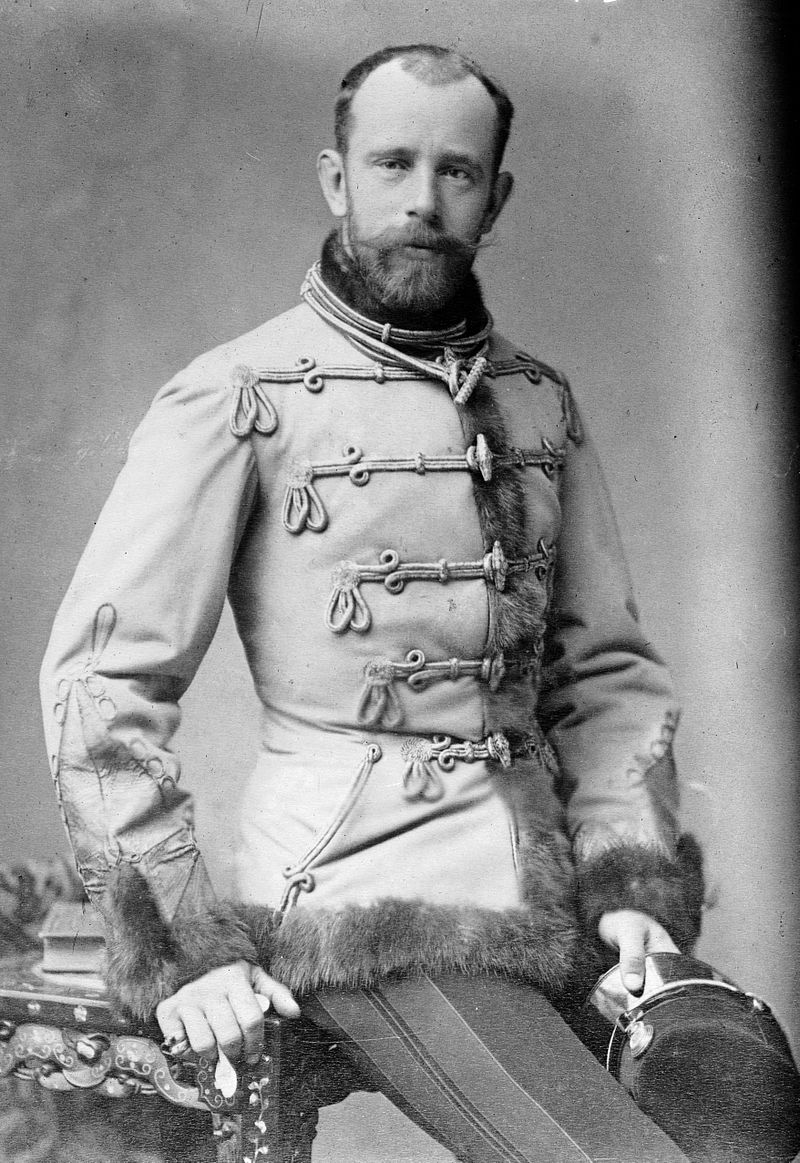
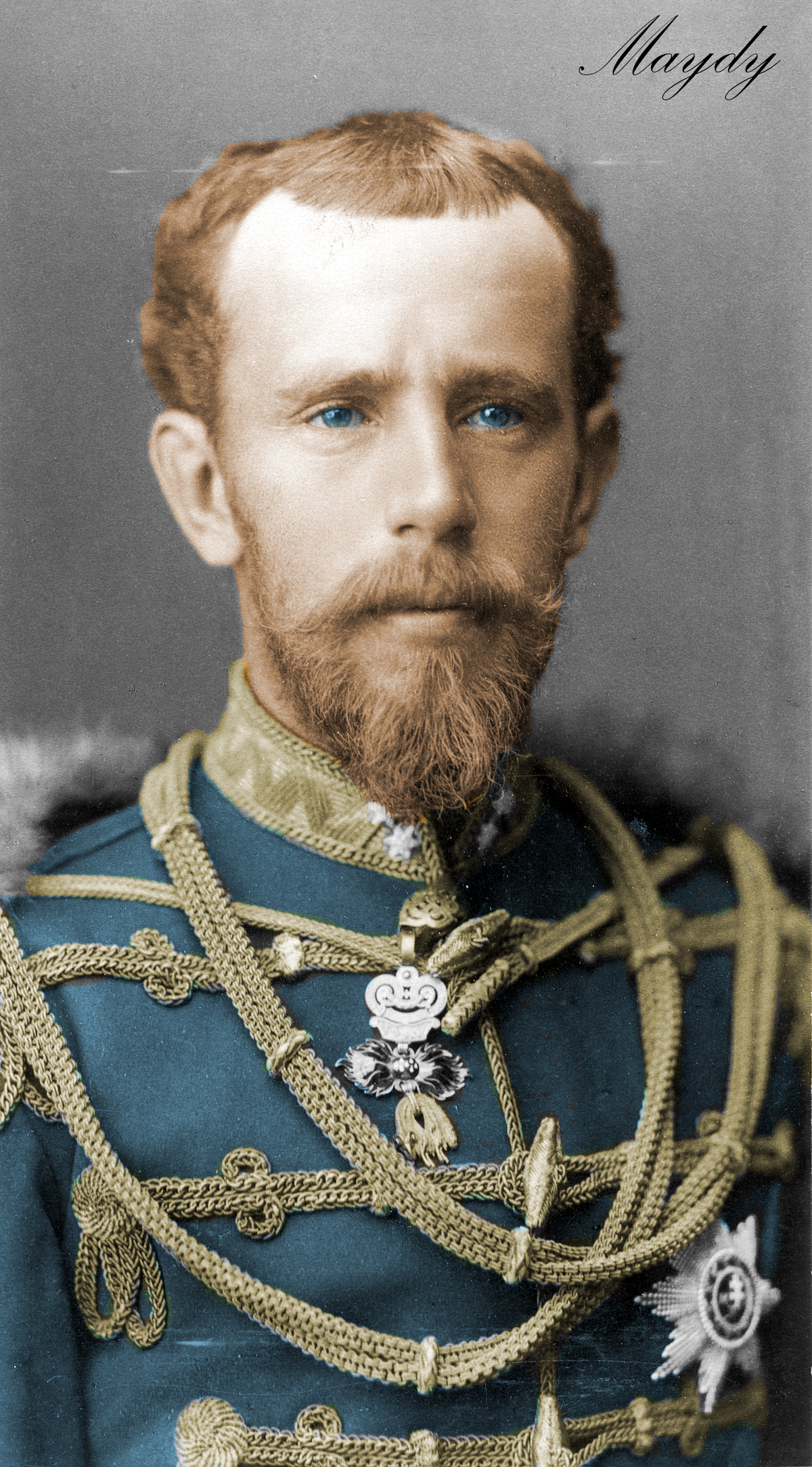
Love and death of Mary Vetsera – Youthful confessions
Vienna, 1884: When she was 17, Countess Marie Mittrowsky asked her friends to write in a very special book. Entitled “Confessions” and printed in London, it contained a catalogue of 24 questions. The answers to these questions yielded a meaningful personality profile not dissimilar to a Facebook profile today. The Confessions of Mary Vetsera are up for auction on 22 June 2016.
Among her aristocratic friends was Mary Vetsera. Aged just 13, the baroness’s answers reveal an educated, independent, imaginative girl with an underlying taste for the morbid, which is expressed particularly in her favourite historical figures.

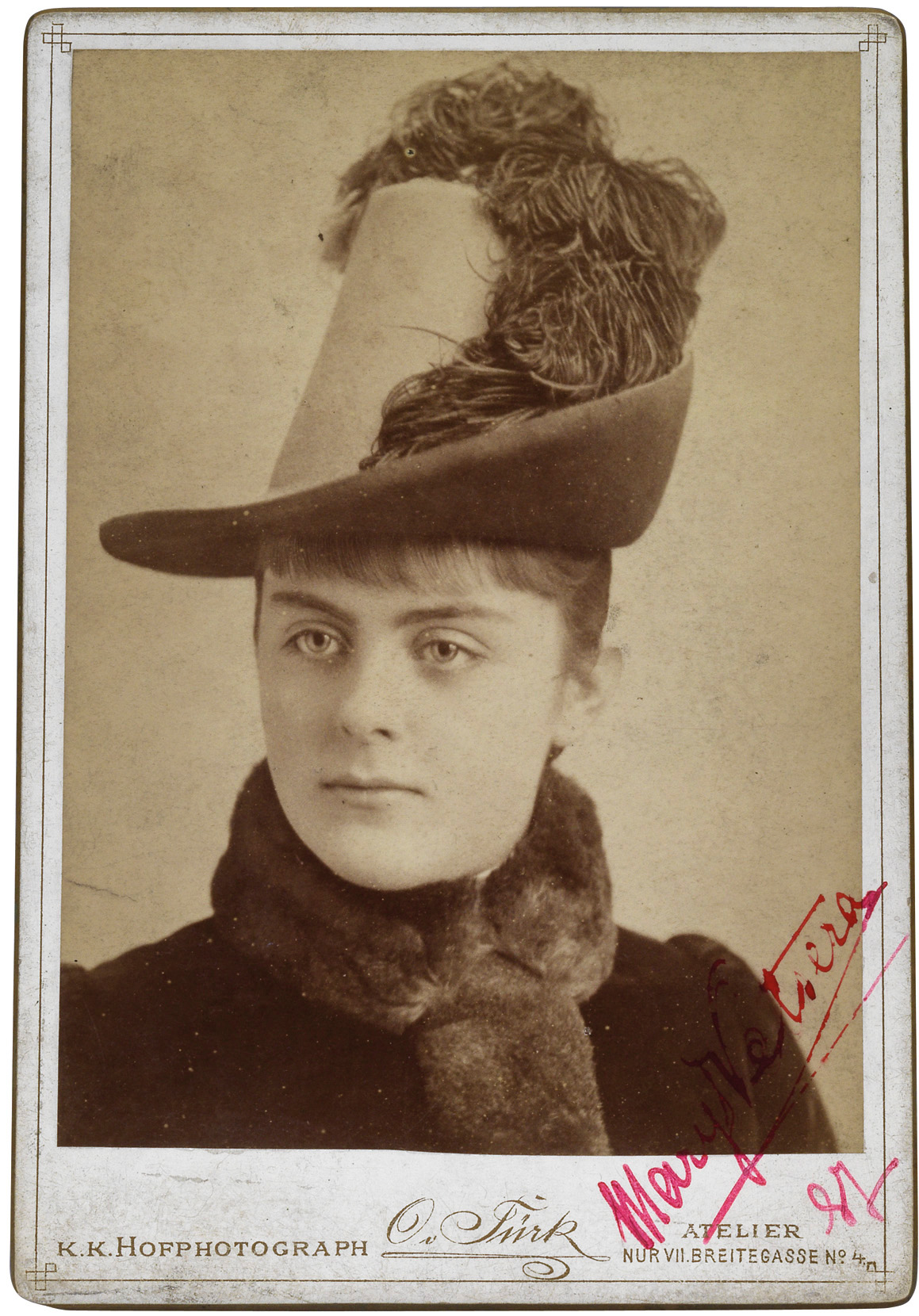
Asked to describe her concept of happiness, Mary Vetsera put six question marks. When asked “If not yourself, who would you be?”, Mary answered: “A spirit or a stag.” Her favourite drinks: Sherry and liqueur. Tolerable fault: Indolence. Present state of mind: Impatience. Favourite writer: Sándor Petőfi, hero of the Hungarian Revolution, killed in 1849. Favourite painter and composer: Hans Makart, Superstar of the Ringstrasse era, and Ludwig van Beethoven. Other favourites included Bertrand du Guesclin, a French military leader in the Hundred Years’ War; Maria Stuart, who was beheaded in 1587; Charlotte Corday, who murdered Jean-Paul Marat and was guillotined in 1793; Siegfried, the hero of the Nibelungen saga who was treacherously murdered; and Medea, the passionate and bleak sorceress and killer from the Argonaut saga.
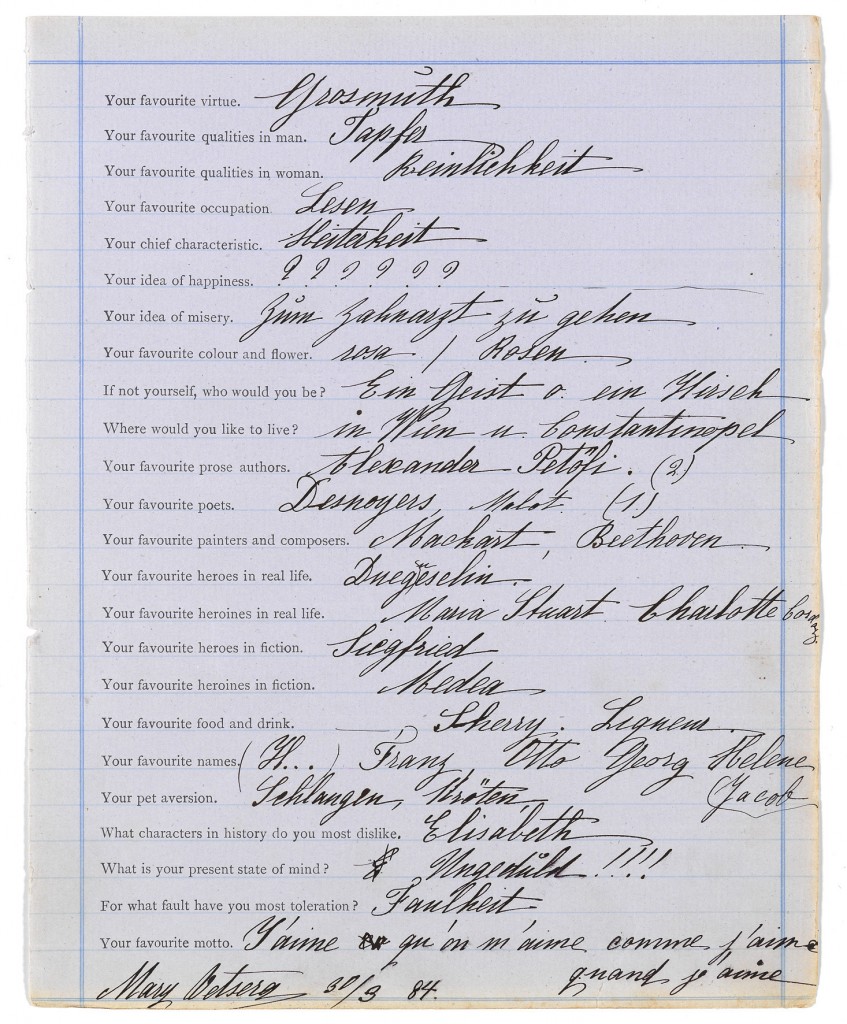
Vetsera’s most hated historical figure was Queen Elisabeth I. of England, who had her rival Maria Stuart executed. Mary ended her entry on a conciliatory note, with a quote from Blanche of Castile, Queen of France in the High Middle Ages. It is an entry that is still found in countless French Facebook profiles today: “J’aime qu’on m’aime comme j’aime quand j’aime.” In Mary Vetsera’s youthful confessions, love and death lie close together – as they did when, five years later, she chose to die a liebestod (love death) with Rudolf, Crown Prince of Austria.
(myART MAGAZINE No. 07/2016)
Information: Andreas Löbbecke heads the autographs department at Dorotheum. Georg Ludwigstorff heads the Imperial Court Memorabilia and Historical Objects department.
Autographs Auction
Wednesday, June 22– 1pm
Palais Dorotheum Vienna
Viewing from 15 June – 22 June 2016
Imperial Court Memorabilia and Historical Objects
Monday, June 20– 2pm
Palais Dorotheum Vienna
Viewing from 14 June – 20 June 2016

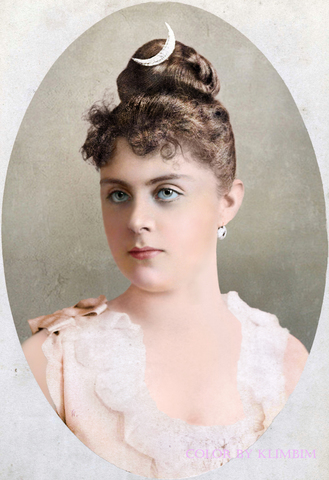
Freiin Maria Alexandrine von Vetsera |
|
| Datum van Geboorte | |
| Plaats van geboorte: | Vienna, Austria (Oostenrijk) |
| Overlijden: | circa 30 maart 1889 (14-22) Slot MAYERLING, Alland, Baden District, Lower Austria, Austria (Oostenrijk) |
| Naaste familie: | Dochter van Freiherr Albin Johannes von Vetsera, vrijheer en Helene Freifrau von Vetsera, baronesse Ex-partner van Rudolf, Kronprinz von Österreich-Ungarn Zuster van Baroness Johanna Carolina Elisabeth Gräfin Bylandt; Ladislaus (László) von Vetsera ; Freiherr Franz Albin von Vetsera en Charles Ladislaus Holt (Vetsera) |
|---|---|
About Baroness Mary Vetsera
Rudolf killed Mary, it was not suicide I toliko eksploatirana drama u Mayerlingu, u kojoj je prijestolonasljednik Rudolf ubio svoju ljubavnicu Mary Vetseru nije u našoj Opatiji prošla nezapaženo. Vlasnica opatijske vile br. 143, bila je udana Baltazzi. Brat njezinog muža Aristida, Alexander Baltazzi i njezin stric Georg grof Stockau obavili su onu opskurnu noćnu vožnju iz Mayerlinga do groblja u obližnjem selu posadivši između sebe mrtvu Mary, čiju je uspravnost u vožnji kočijom jamčila ugurana letva za vratom. Priča gotovo kao izmišljena za salonske skandalozne opatijske tračeve. Mary Vetsera je bila kćer Helene Baltazzi, sestre Arstida Baltazzia, supruga naše Opatijke.
The death of Marie
The truth is hidden, we will not all know the truth about when Marie or her lover Rudolf died. History is probably different in this case then we all think to know.
Marie Vetsera, or Mary, as she preferred to be called, was no innocent flower either. She came from minor nobility, but as a mere Baroness she was not admitted into inner Imperial circles. Her father, Albin von Vetsera, was a career diplomat, awarded the title by Frans Josef for his services. Her mother, Helene Baltozzi Vetsera came from an extremely wealthy cosmopolitan family whose fortunes were made in the Levant. Albin spend most of his career away from his family on various official missions. Helene, twenty-two years younger, took advantage of his numerous absences to conduct extra-marital affairs, including, possibly Rudolf when he was in his early twenties. The family had ennobled relatives in England, moving in the fast set of the Prince of Wales there, and Mary was raised to be fluent in several languages. By the time she was in her mid-teens, Mary had blossomed into a very voluptuous and flirtatious femme fatale. Her mother raised her and groomed her to marry well in the highest circles of nobility, hopefully to gain access to the courtly inner sanctum. She evidently did not worry about her daughter’s virginity in the process. Helene engineered Mary into Rudolf’s presence whenever possible, and Mary duly became infatuated, and by the time she was sixteen, was embroiled in what started out to be a passionate love affair with the Crown Prince, including visiting him once in his palace apartment clad only in a nightie with a fur coat on top.
Mary was aided and abetted by a rather shady court parasite, Countess Marie Larisch (Marie Gräfin Larisch-Wallersee). Countess Larisch was a niece of Empress Elizabeth, who basically made her way through court life via pandering and blackmail. Using her courtly connections, she encouraged the liaison between Mary and Rudolf. The prince’s reputation as far as women were concerned was certainly well-known, but Mary flaunted her relationship with him in a very brazen way, most notably refusing to curtsy to Princess Stephanie at a diplomatic reception. If she wasn’t so blatant she might have aspired to become his official mistress, just as Katherina Schratt was with Frans Josef. Though there are stories that Rudolf tried and failed to secure an annulment from his marriage to Princess Stephanie, it certainly wasn’t in order to marry Mary, and there is now evidence to suggest that the time of his suicide, he was pursuing other women as well as keeping his friendship with Mitzi Kaspar.
Mary’s distinction, then, was so tangled up in infatuation, bad advice and fantasy that she became a consensual partner in Rudolf’s double suicide plan (he had previously asked various male friends and Mitzi Kasper to join him in this pact, but they refused).
What finally set Rudolf to take his own life was the failure of the latest Hungarian conspiracy to break away from Austria, in this case offering him the crown of an independent Hungary. Perhaps he saw this as his last chance to make a contribution to his imperial heritage. At any rate, he shot Mary, and then sat with her body for six hours before he shot himself.
To avoid an imperial scandal, the government of Frans Josef enacted a coverup, burying Mary in secret in the monastery of Heiligenkreutz and giving Rudolf a state funeral, concealing his suicide with various prevarications so that he could have a Catholic state burial. In consequence, much of the evidence and documentation was hidden or destroyed.
Over the years, details of this scandalous story were either leaked, or rediscovered, and Wilson and King’s study does a great deal to clarify what could be pieced together. It seems that, as with other contemporary royal dynasties, the period of their glories lay far behind, and almost all of them would perish with World War I.
In spite of all the murkiness, Maurice Anet’s tale of star-crossed lovers and its movies endured during the 20th century for over 30 years. But the story also inspired other interpretations in film, dance, plays and a miniseries of the Mayerling legend right into the 21st. century, though with tweaks as new evidence surfaced. These will be explored in part II of this blogpost.
Part I https://jbsmusings.blogspot.com/2018/06/star-crossed-lovers-probabl…
Part II https://jbsmusings.blogspot.com/2018/07/star-crossed-lovers-probabl…
https://www.geni.com/people/Baroness-Mary-Vetsera/6000000004553271823
http://www.liburnija.net/devet-bisera-opatijskih-kruna-stockau/
The Mayerling Incident

The players:
 Rudolf Franz Karl Joseph, Crown Prince of Austria
Rudolf Franz Karl Joseph, Crown Prince of Austria
He was 30. She was just 17. He was the heir to the empire and she was a young baroness, and they were lovers.
On the morning of January 30, 1889 their bodies were discovered by the staff of the prince’s hunting lodge at Mayerling (in Austria, outside Vienna). By all appearances the prince had shot Mary some time in the night, then sat with the body and booze until he worked up the courage to shoot himself early the next morning. They both left behind several suicide notes.
Upon receiving the news, the horrified royal family (including Rudolf’s wife Stephanie) flew into action, announcing Rudolf’s official death of heart attack, and smuggling Mary’s body out of the lodge, dressed in street clothes and propped between two men in a carriage. Despite the obvious suicide, his body would be interred in Imperial Crypt in Vienna. She was buried in a plain box, at night, in a nearby cemetery.
Almost immediately rumors began to circulate about the pair, ranging from murder conspiracy plots to musings on their Romeo and Juliet fate. But these were no star-crossed lovers. In fact, Rudolf had spent the previous evening in the arms of his other mistress, whom he had tried, unsuccessfully, to convince to die with him first.

Rudolf was the only son of Emperor Franz Joseph I and the Empress Elisabeth of Austria. His father was famous for his coldness and affairs, his mother for her exquisite beauty and constant traveling. Rudolf was primarily raised by his grandmother, and he was becoming known for his eccentricities and inconveniently liberal politics.
From a young age Rudolf displayed a passion for natural sciences, particularly for birds, publishing 40 ornithological works and assembling vast ornithological and mineralogical collections. His bird-and-rock nerdiness was offset by matched passions for hunting and whoring, both of which he excelled at. His mistresses were well known even before his marriage: In fact, he brought his current mistress along with him when he traveled to Belgium to pick up his bride.
It was this last habit that ended up defining his life. At some point, Rudolf picked up a nasty venereal disease which he passed on to his wife, rendering her sterile and leaving the couple without a male heir. To treat his medical conditions, Rudolf turned to morphine. To avoid his rapidly deteriorating marriage, he turned to his mistresses.
No one completely understands the motivations behind Rudolf’s final days, but a few things seem clear. He was in poor health, possibly addled by morphine, and basically estranged from his wife. He fought with his father about politics and his future as heir. And he turned to his mistress – not Mary Vetsera, but Mitzi Caspar, a Viennese prostitute – and attempted to persuade her to agree to a suicide pact. She declined, and reported the incident to the police, who apparently ignored it.
So on the 28th of January 1889 Rudolf brought Mary to the hunting lodge at Mayerling, and during the night of the 29th, they died.

Epilogue:
Ten years after his death, Rudolf’s mother Elizabeth was stabbed in the heart by an assassin, her death slowed by her tight corset. Her killer was immediately caught, and after his jailhouse suicide his severed head was kept in a jar of Formalin, passed between pathological collections until it was finally interred in 2000 in Vienna’s Central Cemetery.
His father Franz Joseph outlived them all, dying in 1916 in the midst of WWI. As a result of Rudolf’s death and his lack of a son, his uncle became heir to the crown, which he abdicated in favor of his son, Franz Ferdinand. Franz Ferdinand would not live to see that day, because, as most of us remember, he was assassinated in 1914, therby setting off the hostilities of WWI. The empire did not recover from the war, dissolving two years later in 1918.
In an intriguing turn of events, exhumations of Mary Vetsera’s remains in 1959 reportedly found an intact skull, with no bullet hole as had been reported. Speculate wildly!
Even more intriguingly, in 1992 her grave was found to be empty, and it took local authorities nearly a year to track down the culprit. He turned out to an Austrian businessman who was obsessed with the mystery of the deaths. He had secretly dug up and stole Mary’s body in order to examine it. She was reinterred in October 1993.
Despite the dubiousness of Rudolf and Mary’s love affair, their story has nevertheless inspired many authors, playwrights, and filmmakers.
Here is a rather hot pas-de-deux from the Royal Ballet in 2009
https://www.atlasobscura.com/articles/morbid-monday-unhappy-prince-and-dead-baroness-mayerling-incident
Welke zij voor ogen had, weet ik niet, ik voeg deze maar toe:
Rudolf Nureyev and Merle Park – The Nutcracker Gran Pas De Deux 1963
1963 – The Royal Ballet: Gran pas de dex, The Nutcracker act2
Rudolf Nureyev
Merle Park
Crown Prince – Trailer
If this story is true, it really is heartbreaking! To know that this young man wanted to elevate his ppl and due to politics and an unbearable father his hopes were drowned all while seeing any opportunity to make things right be thwarted by the failing system of sychophants, backstabbers and hypocrites. Really sad for what could have been an incredible Austria if Rudolf lived 😞 ~nevilleandjudith
Magdalena Kožená – Pražské jaro 2023
Ústřední místo v repertoáru Magdaleny Kožené patří písňové tvorbě. A právě písně francouzských autorů, plné lyriky, neotřelých harmonií a jemných barev, uvede ve Dvořákově síni Rudolfina. Doprovodí ji její pravidelná umělecká partnerka Mitsuko Uchida, jedna z nejvýše ceněných klavíristek posledních dekád. Magdalena Kožená v zahraničí patří mezi nejvyhledávanější české umělkyně. Každé její pražské vystoupení je mimořádnou událostí a vzácnou příležitostí pro domácí publikum slyšet její umění. Když s Mitsuko Uchidou v roce 2012 vystoupila na Pražském jaru poprvé, recenzenti vyprodaný koncert označili za vrchol festivalu.
Magdalena Kozena – Scherza infida
Scherza infida – Georg Friedrich Handel Paleis voor Schone Kunsten – Brussel Venice Baroque Soloists – Andrea Marcon
900638 Ondrej Adamek – Simon Rattle – BRSO – Magdalena Kozena
ENGLISH below
musica viva
ONDŘEJ ADÁMEK
Follow me ∙ Where are You?
Der 1979 in Prag geborene Komponist, Dirigent und Chorleiter Ondřej Adámek, der in seiner tschechischen Heimatstadt und in Paris studierte, wurde für seine Orchester-, Kammer-, Vokal- und elektroakustische Musik bereits mit zahlreichen renommierten Preisen ausgezeichnet. In seiner musikalischen Sprache, die sich immer wieder auch Elemente ferner Kulturen einverleibt, lässt er ungewöhnliche musikalische Erzählungen entstehen. Die Authentizität seiner Interpretationen sucht er vermittels der Kombination von Stimmen und Bewegungen, von Gestik und Theatralik, von phonetischen und semantischen Aspekten sowie einem eigens entwickelten Musikinstrumentarium herzustellen.
Für die Geigerin Isabelle Faust, eine der virtuosesten und gleichzeitig feinsinnigsten Violonistinnen unserer Zeit, und als Auftrag der musica viva hat Adámek sein Stück „Follow me“ geschrieben, das seine Uraufführung am 15. Dezember 2017 im Herkulessaal der Münchner Residenz erlebte. (Kompositionsauftrag der musica viva des BR, der Freunde des Symphonieorchesters des BR e. V., des Helsinki Philharmonic Orchestra und des Festival Musica Strasbourg.) In dem dreisätzigen Konzert für Violine und Orchester (2016/17) werden die Melodien nach dem Vorbild der spätmittelalterlichen Hoquetus-Satztechnik zwischen der Solistin und dem Orchester aufgeteilt, wodurch der Komponist ein einzelnes Individuum mit einer (Menschen)Menge in Verbindung zu setzen sucht.
Den Kompositionsauftrag für „Where are You?“ für Mezzosopran und Orchester (2020) erhielt Adámek von der musica viva des BR und dem LSO, gefördert von der Ernst von Siemens Musikstiftung; die Uraufführung vom 6. März 2021 in der Philharmonie im Gasteig – mit Magdalena Kožená und dem Symphonieorchester des Bayerischen Rundfunks unter Leitung von Simon Rattle, dem zukünftigen Chefdirigenten des Weltklasseorchesters – war ein herausragendes Ereignis im Münchner Konzertprogramm dieses Jahres. In dem elfteiligen, etwa 35-minütigen Klangkaleidoskop, das von andauernder motorischer Bewegung beherrscht wird – von Alltagsgeräuschen wie dem monotonen Ticken einer Uhr bis hin zum weit aufschwingenden, elektrisierend-rhythmischen Stampfen des Orchestertuttis – begibt sich der Komponist auf eine Suche nach dem Menschlichen („Woher kommen und wohin gehen wir?“) wie dem Göttlichen.
———————-
Born in Prague in 1979, the composer, conductor and chorus master Ondřej Adámek, who studied in his Czech hometown and in Paris, has already won numerous prestigious awards for his orchestral, chamber, vocal and electro-acoustic music. In his musical language, which also repeatedly incorporates elements of distant cultures, Adámek creates unusual musical narratives. He seeks the authenticity of his interpretations by combining voices and movements, gestures and theatricality, phonetic and semantic aspects, and his own specially developed musical instruments.
As a commission for Bavarian Radio’s musica viva, Adámek wrote his piece “Follow me” for the violinist Isabelle Faust, one of the most virtuosic and at the same time most subtle violinists of our time, and the work received its world premiere on December 15, 2017 in the Herkulessaal of the Munich Residenz. (Composition commissioned by Bavarian Radio’s musica viva, the Friends of the BRSO e.V., the Helsinki Philharmonic Orchestra and the Festival Musica Strasbourg). The melodies in Adámek’s three-movement Concerto for Violin and Orchestra (2016/17) are divided between the soloist and the orchestra along the lines of the late medieval hocket technique, whereby the composer seeks to connect a single individual with a (human) crowd.
Adámek received the commission for “Where are You?” for mezzo-soprano and orchestra (2020) from Bavarian Radio’s musica viva and the LSO, supported by the Ernst von Siemens Music Foundation. The premiere on March 6, 2021 at the Philharmonie im Gasteig – with Magdalena Kožená and the Bavarian Radio Symphony Orchestra conducted by Simon Rattle, the world-class orchestra’s future principal conductor – was an outstanding event in Munich’s concert programme this year. In the eleven-part, approximately 35-minute-long kaleidoscope of sound, dominated by constant motoric movement – ranging from everyday sounds such as the monotonous ticking of a clock to the sweeping, electrifyingly rhythmic pounding of the orchestra tutti – the composer embarks on a search for the human (“Where do we come from and where are we going?”) and the divine.

Paganini – Minuetto per L’Amandorlino for Mandolin, MS 106 (Minuetto)














